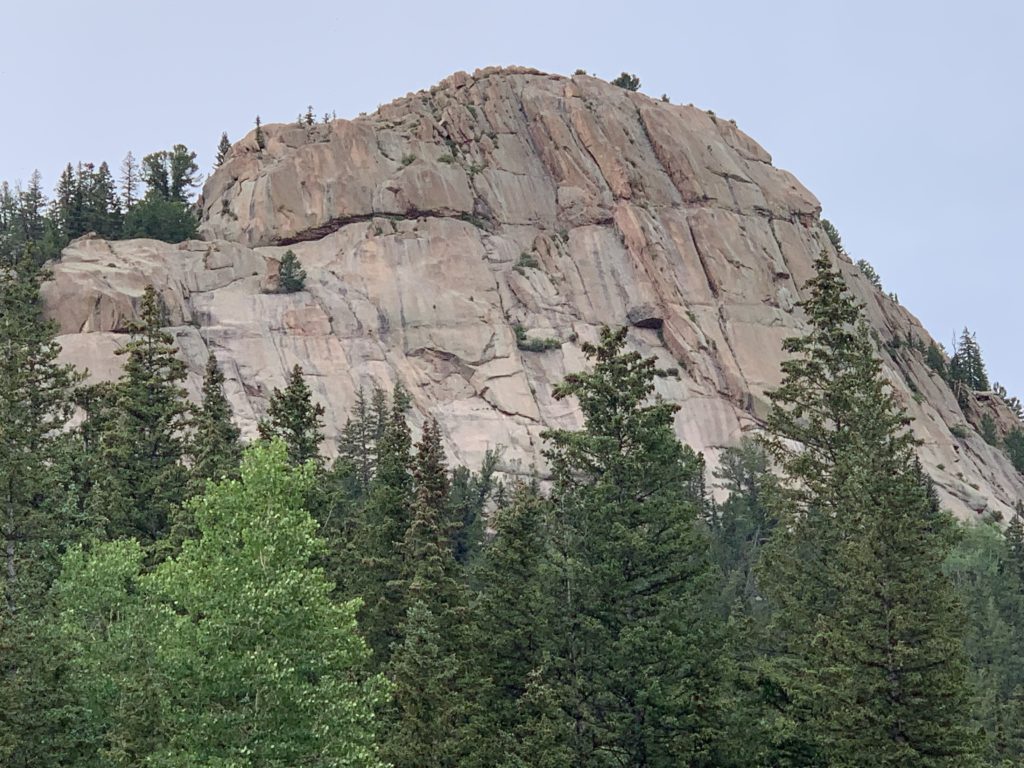
Thunder bounces off the granite back of Pikes Peak Mountain in Colorado rattling my camp and my bones. Lighting splinters the peace of cascading streams in the spruce and pine forest fringing the sheer cliffs and jagged trails of The Crags of Colorado.
Electrical storms in the highlands of central Colorado powerfully ricochet from rock to rock creating a cacophony so intense the area has been dubbed The Devil’s Playground.
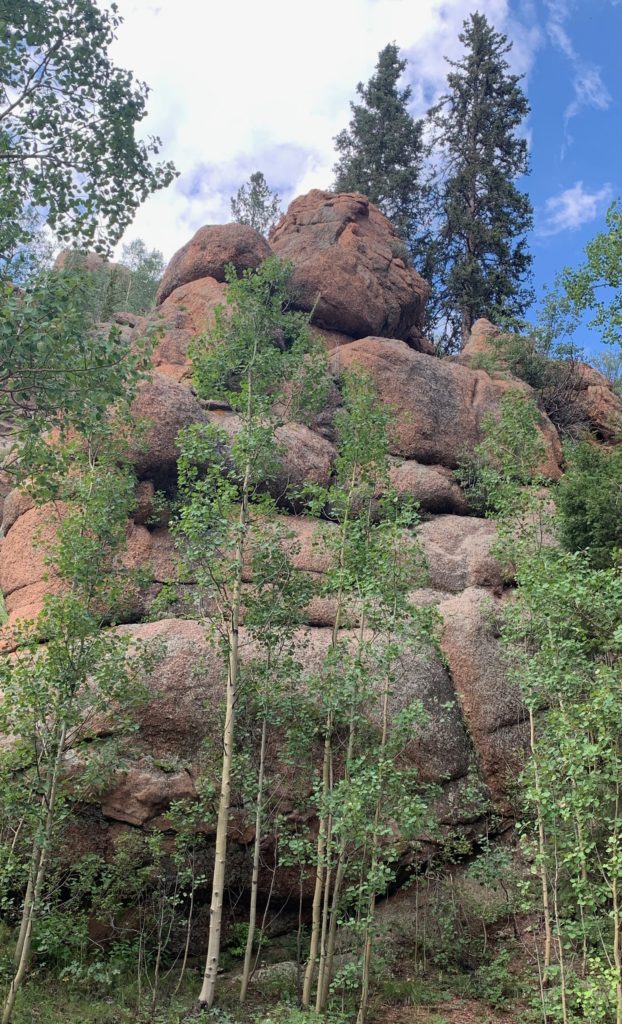
The northwest peak area has a reputation as the “wild side.” Life is steep and jagged near Ute Pass and can seem impenetrable with deep shadows, and massive, rounded boulders perilously eroded and impossibly stacked.
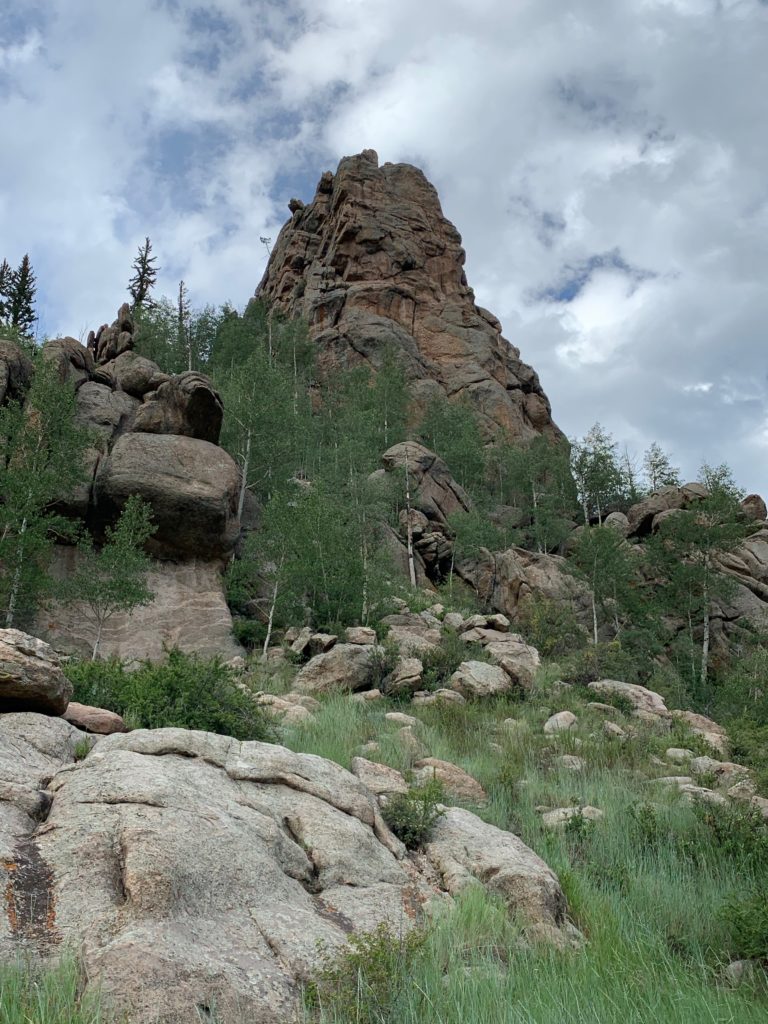
Storms That Make My Ears Ring
Thunder booms catch my breath in this precarious boulder balance. For just a breathe everything stops while instinct takes over.

Over the years I’ve tried to train mountain thunder as a Call to Prayer practice of many religions. There is typically a sound that indicates it’s time to stop life for a bit to pray and reflect.
Thunderstorms bouncing through the valley is my cue. Instinctually it immediately focuses all my senses in the moment to breathe, assess, then lean into it in the deep peace, trusting all is well. If I actually need to take action that direction will come in the calm too.

Typically my best strategy is to get to shelter, relax, and ride it out. In a hyper-aware state, it can be difficult to chill out. That’s where meditation practice pays off with a conditioned response, releasing lovely biochemicals that lower heart rate and respiration, and clear and center the mind – l
That deep, meditative peace floods my being, allowing me to be present with whatever is going on – even if just for a moment. It’s big medicine for my body, not to mention mind and spirit, especially if I’m nervous.
Home Sweet Home
A tiny but sturdy, and cozy teardrop trailer is also prime real estate in intense mountain thunder, lightning, and rain. E
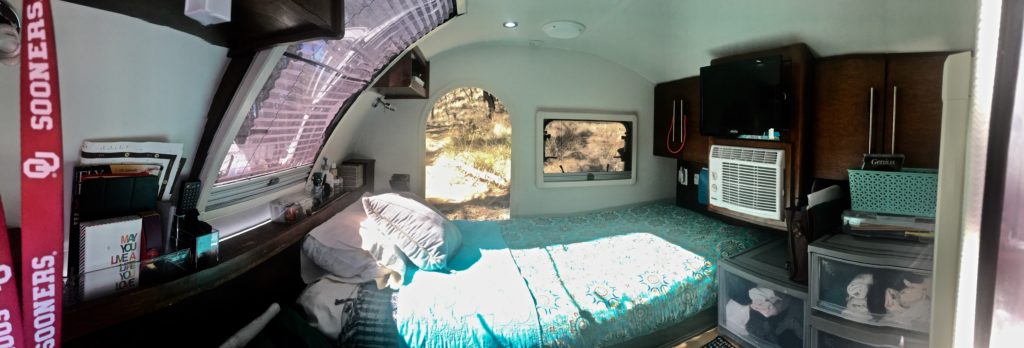
Built for Rugged, Small Rigs and Tents
Like most places I love, big rigs will have a difficult go on the rough road to the national forest’s Crags Campground. There are only 3.5 miles of barely passable narrow, rough forest road, but it can take 30 minutes of
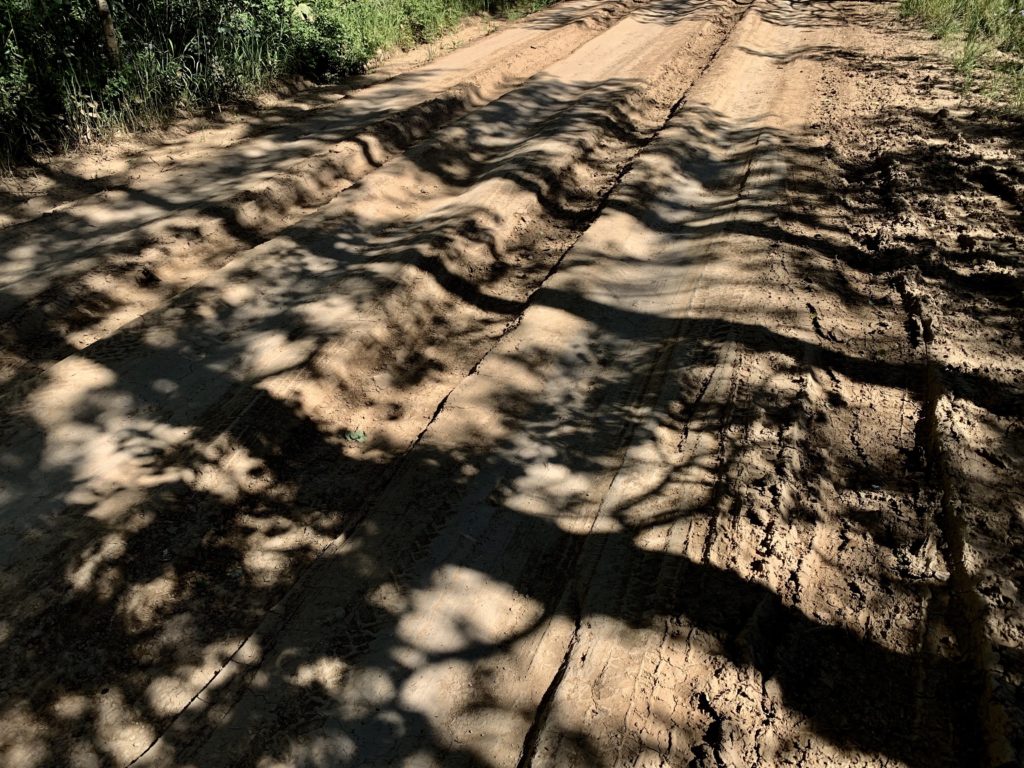
Mixed pine, spruce, and aspen forest shades a primitive, rustic campground tucked into a portal deep into the western slopes of Pikes Peak National Forest.
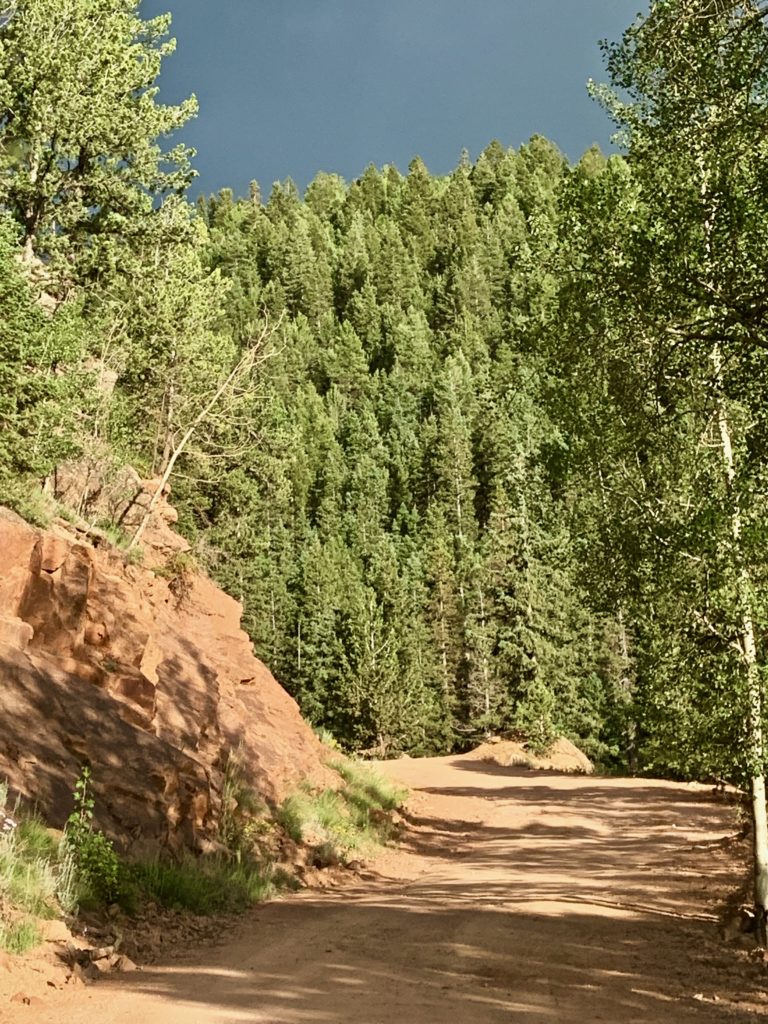
Sites are large, spacious, and relatively private, especially on the ends and outside edges of the grounds.
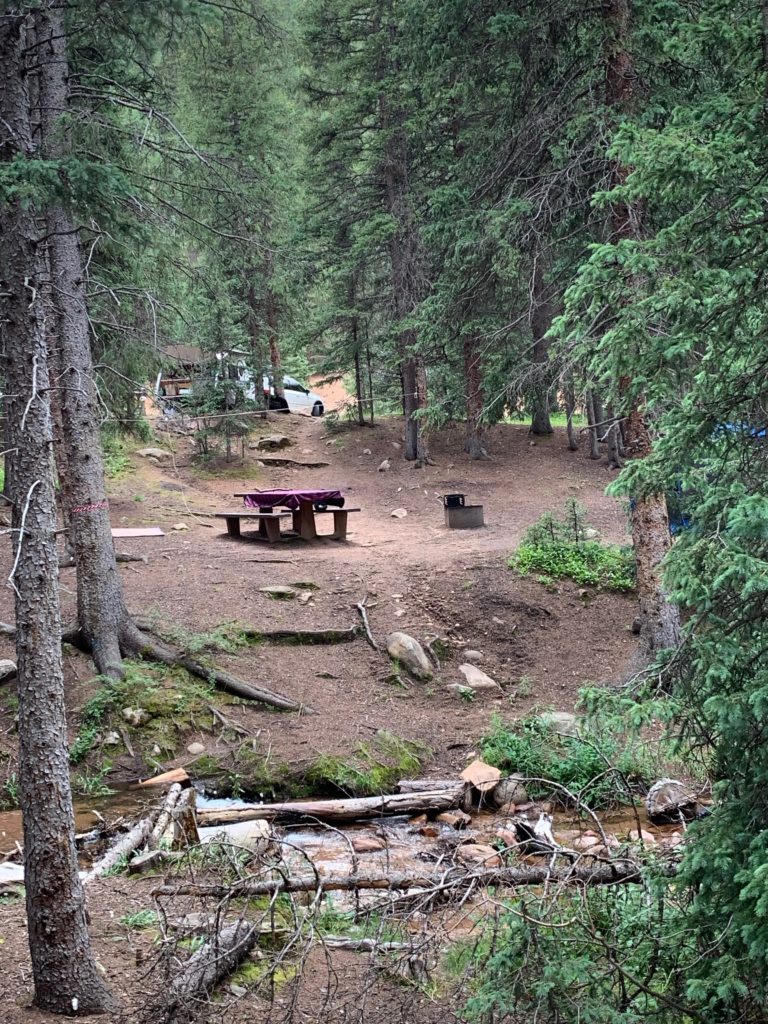
Terracing helps level tent sites on the steep terrain and camp may have two levels like a two-story house. There are a few meadow camps as well, but not as much shade. The sun is intense at almost 10,000-foot altitude.

Fourmile Creek gently cascades through the thick forest dotted with small alpine tundra exploding with summer flowers.
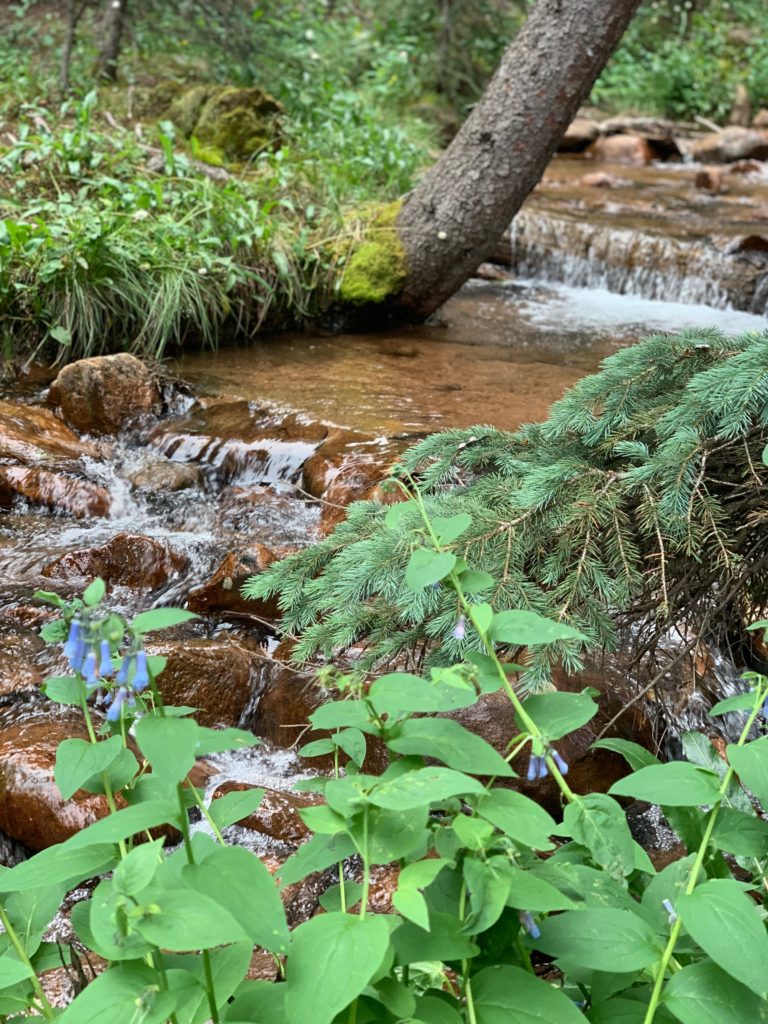
The idyllic environment nurtures deep and soothing sleep unless the riotous thunderstorms linger. One onerous night I dreamed I was riding in a stagecoach perilously careening around narrow, steep mountain trails. I woke drenched in sweat, the trailer rocking in high winds, thunder exploding into lightning. There was no calming Rocky in that storm, but I was grateful for his distraction from my own time travel dreams.

Hiker’s Paradise
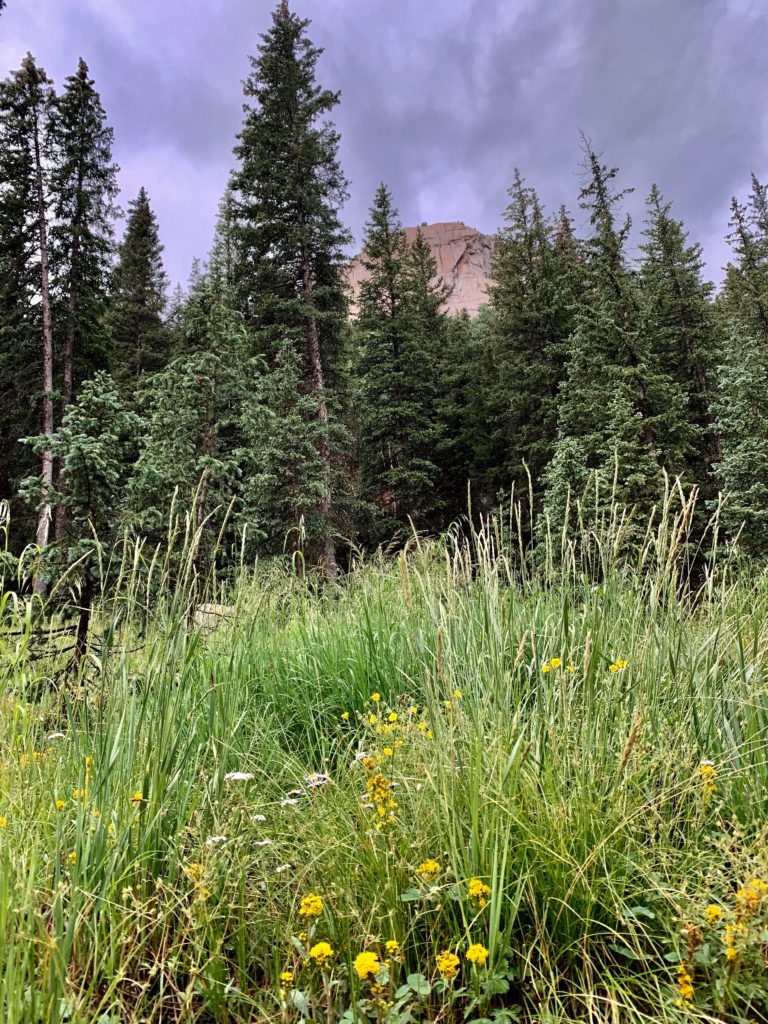
Three hiking trails will satisfy all skill levels. The Crags Trail #664 climbs over 12 miles and 4,000 feet of elevation gain to the summit of Pikes Peak with a newly-rerouted spur Devil’s Playground Trail #753. The design is less vertical and more horizontal with long, winding switchbacks to avoid erosion and make the journey on harsh grades of the fourteener trail easier on hikers.

The Putney Gulch segment of Ring the Peak Trail is also located near the campground. A nearly 360-degree view of the Sangre de Cristo and Collegiate Peaks mountain ranges and North Slope Recreation Area reservoirs rewards hikers.

Access to Gold Medal Fishing
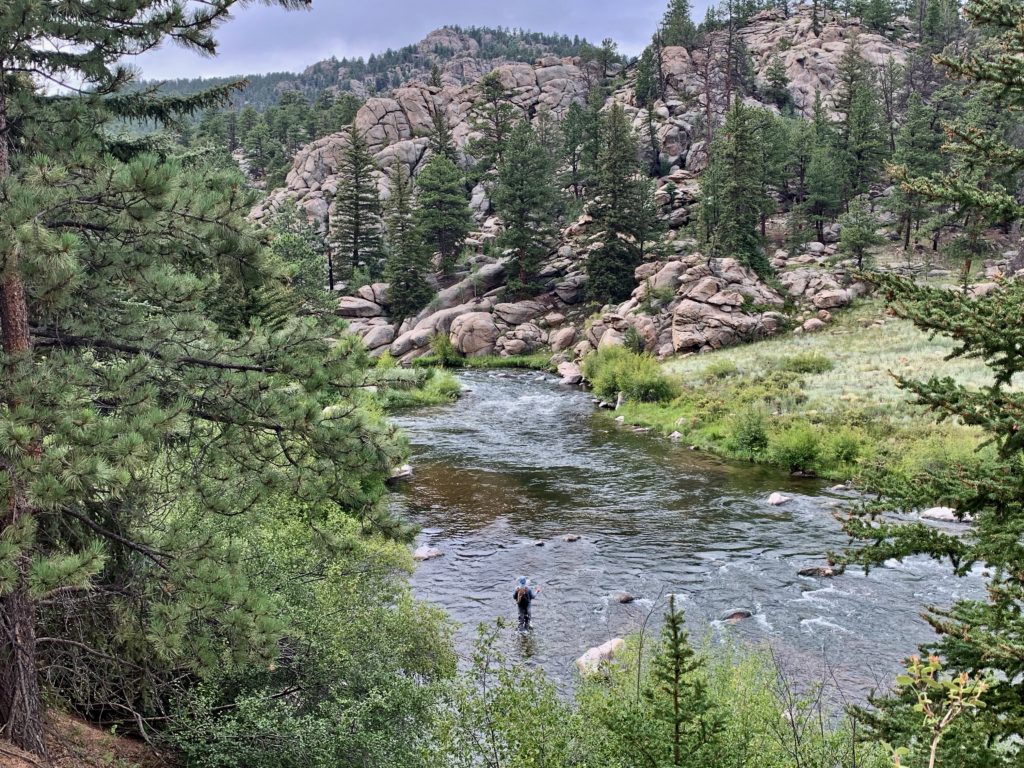
Fly-fishing is less than an hour southwest via US-24 W and Co Rd 96. The popular and highly pressured South Platte River running through the scenic Eleven Mile Canyon will test your skill. If that’s not enough, Eleven Mile Reservoir is above the dam before the canyon on CR 92.

The Crags Campground Specs
The Crags Campground site was designed for tents and small, rugged, RVs and trailers. There are no modern conveniences or electric hookups. There are pit toilets, potable water spigots (the high mineral content can be hard on the stomach), fire rings, and picnic tables. No trash service is provided at the campground, so everything packed in must be packed out.
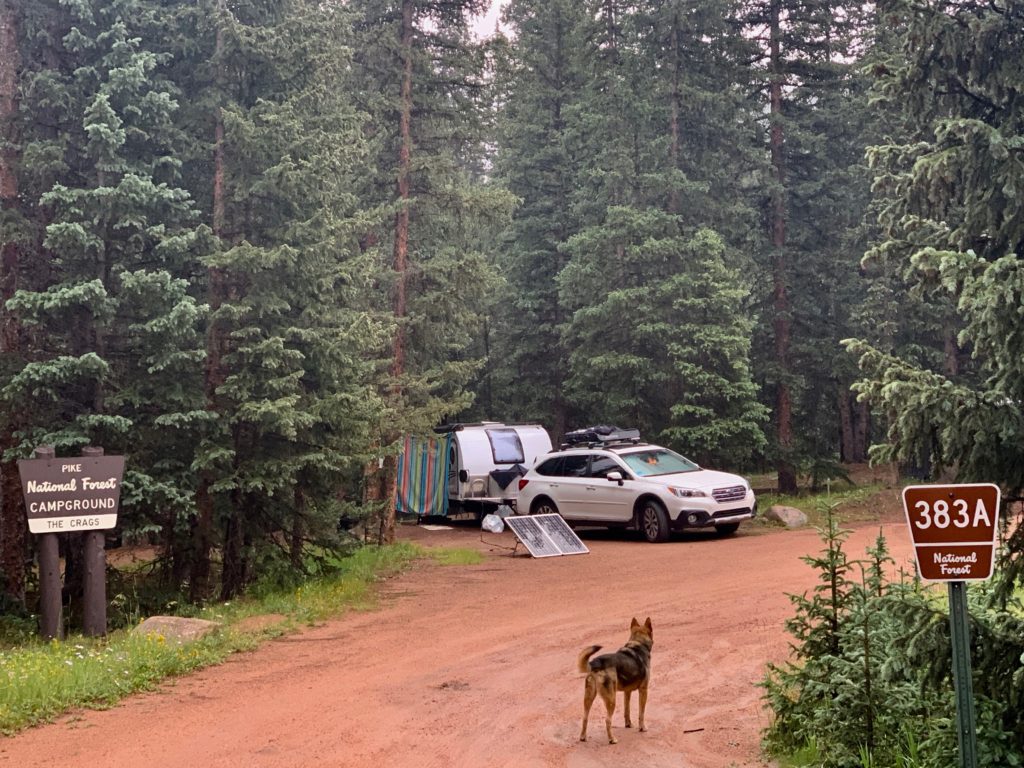
There are also no giant RVs crammed next to each other.
Reservations are not accepted in this first-come, first-served only campground managed by the Pikes Peak District of the U.S. Forest Service contracting with concessionaires to operate the site. Fees are $18/ night although Golden Age and Access Pass holders are usually 50 percent off – depending on the contractors.
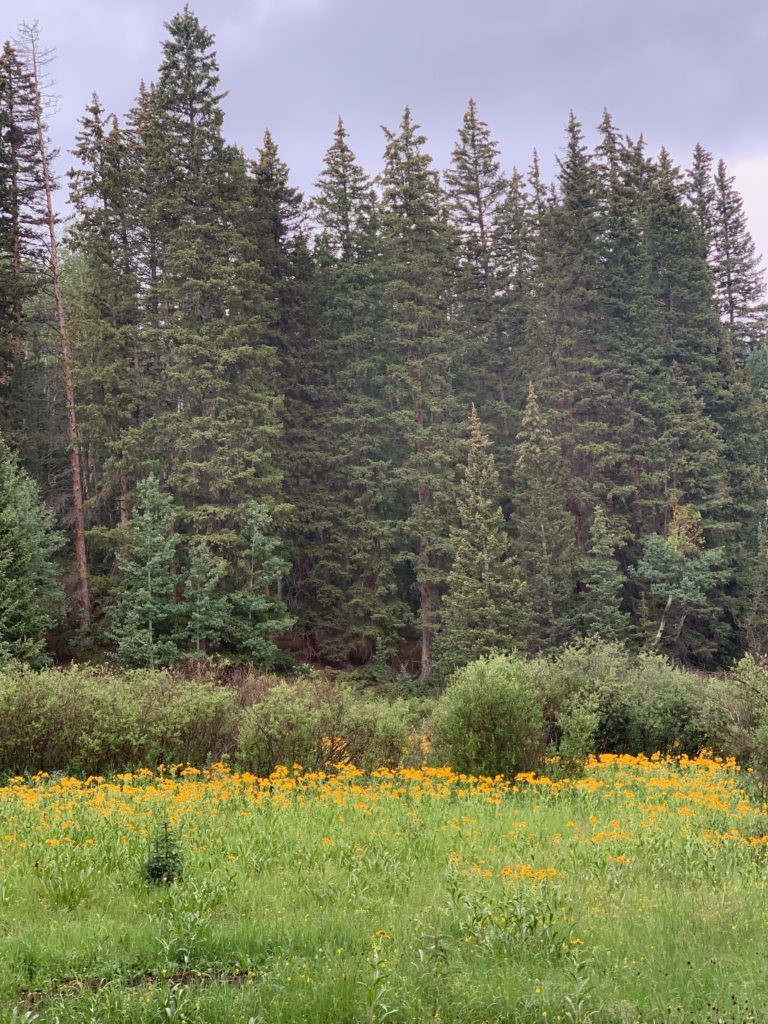
This wild western side of Pikes Peak gets the most snow, so the season is relatively short and wet. Camp opens Memorial Day and closes the end of September – weather permitting.
Dispersed Camping Available in Pike National Forest

Pike National Forest surrounding Crags Campground has free, dispersed, backcountry camping sites close to the trails but these may or may not be closed depending on the latest conditions and behavior of campers.
Please follow Leave No Trace rules for backcountry camping. It’s definitely an honor code you can live with if it helps keep the backcountry open for everyone.
Motorized vehicles are not allowed in wilderness areas or these hiking trails. Transportation is by foot, paw, or hoof only.

Directions
Crags Campground is tucked into the forest below Pikes Peak east of Mueller State Park. The bustle of burgeoning Colorado Springs seems a universe away even though it’s just over an hour’s drive on a good highway. (Other than the 3.5 final section of very rough forest road.)

From Colorado Springs, take U.S. Highway 24 west to Divide. Turn left on Colorado Highway 67. Drive 4.3 miles south and turn left on Forest Road 383. Drive 3.5 miles to the east to reach the campground, which is 1/8th mile beyond the large parking area for the Crags trail.
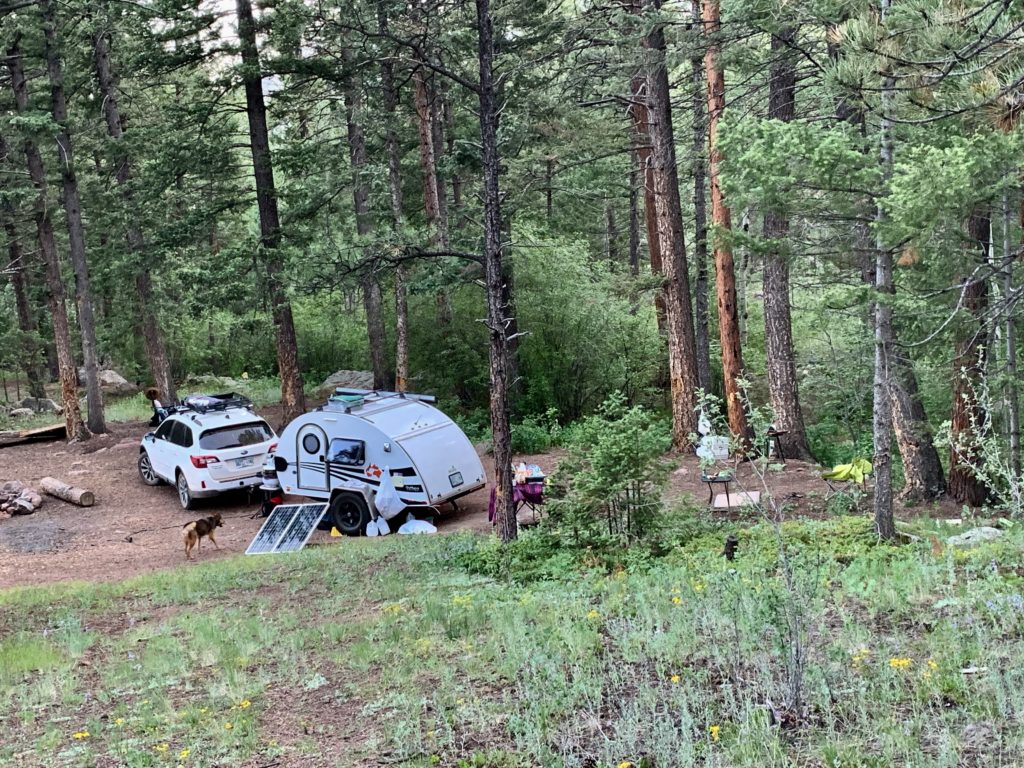
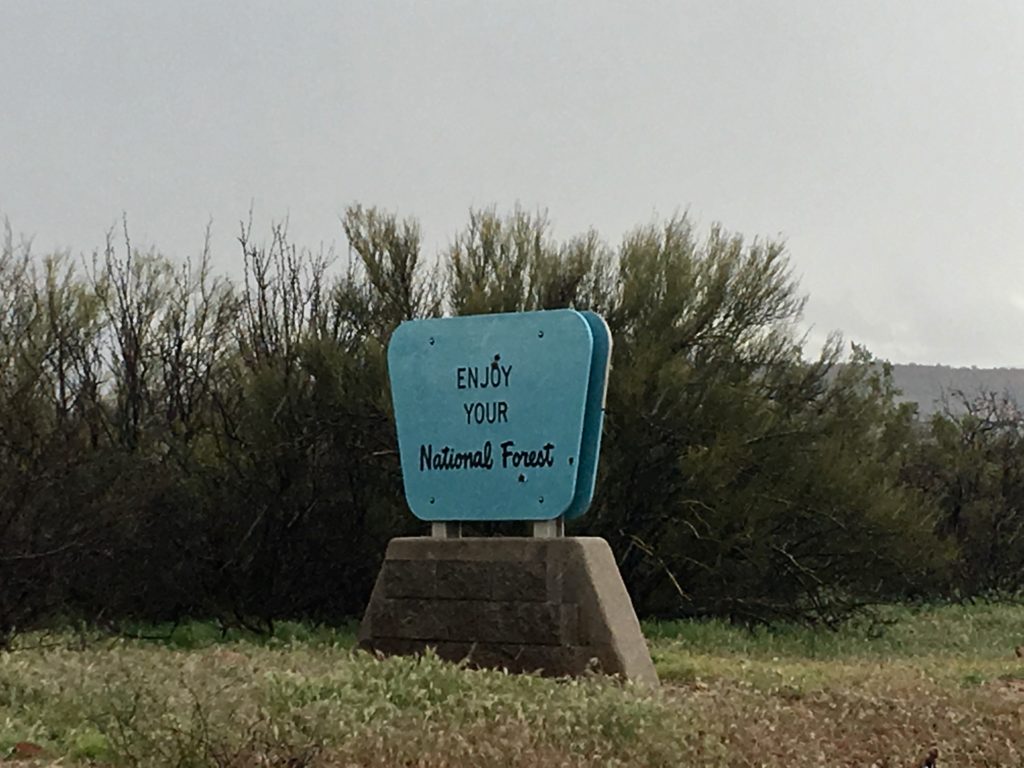

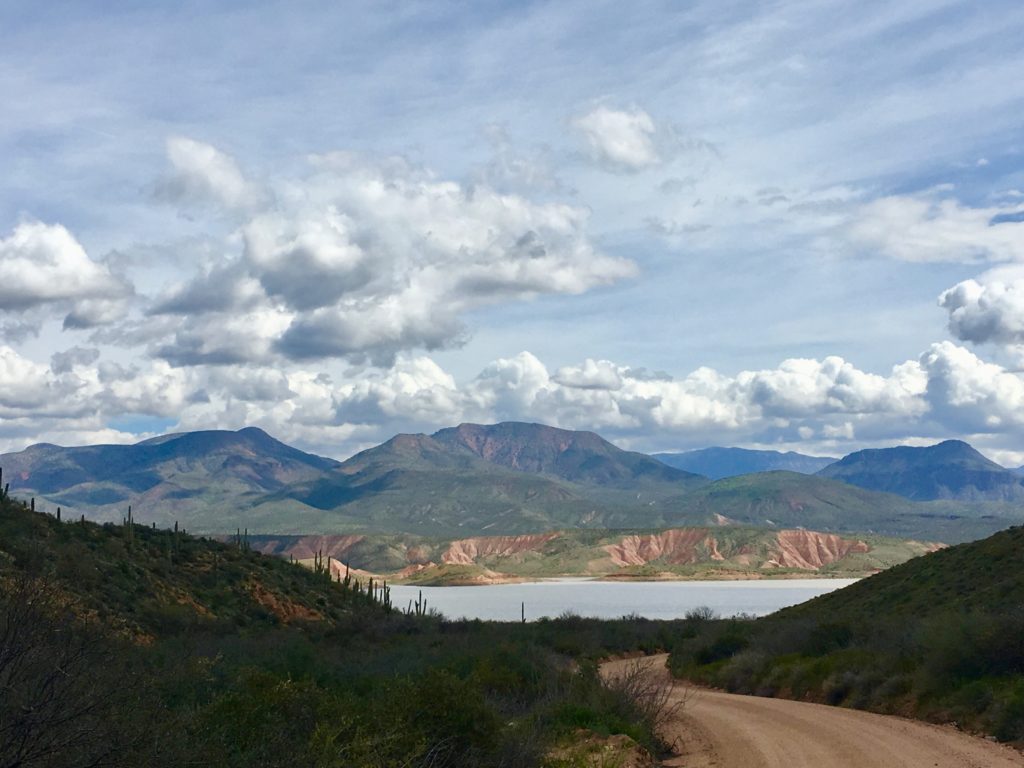
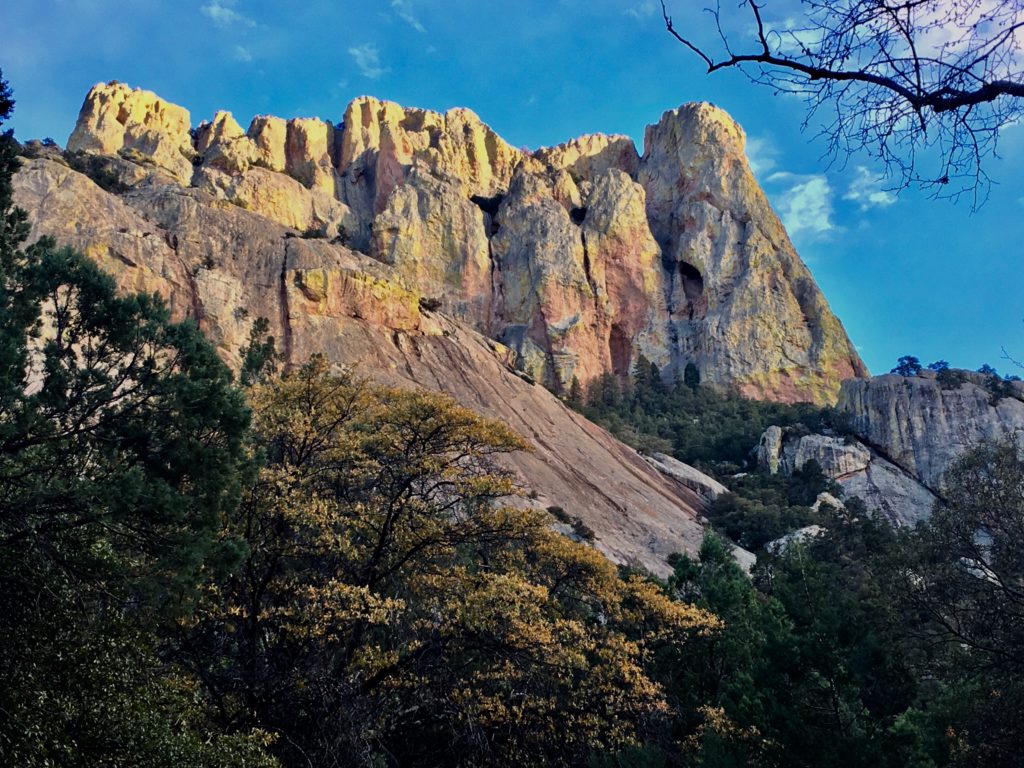

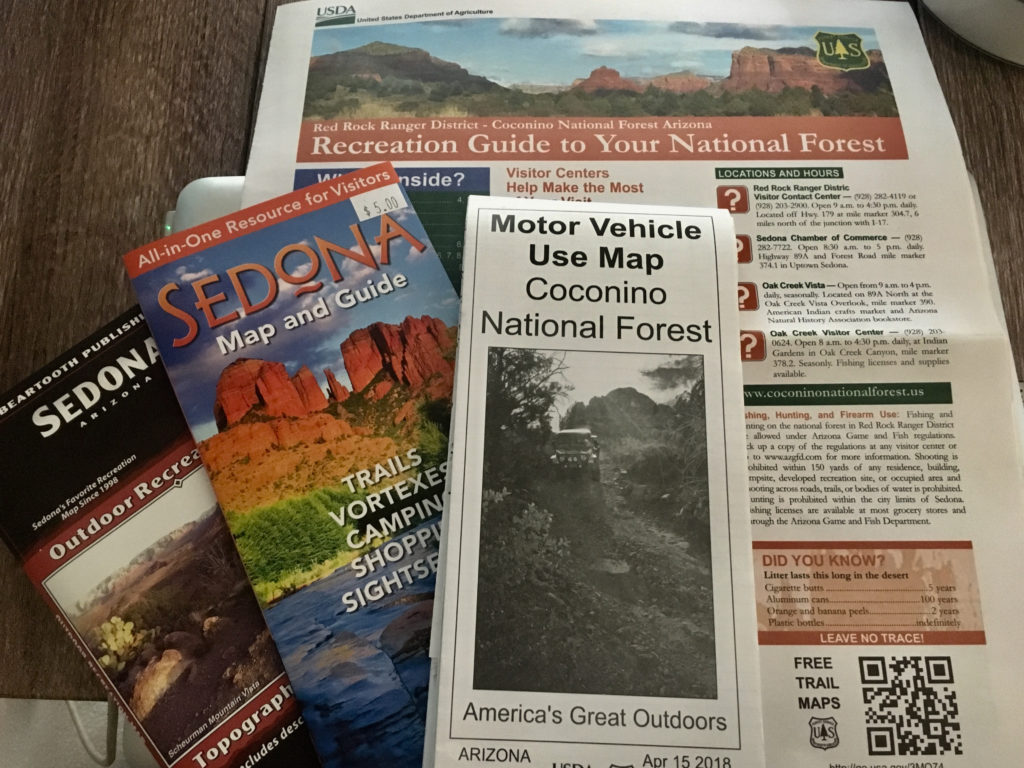

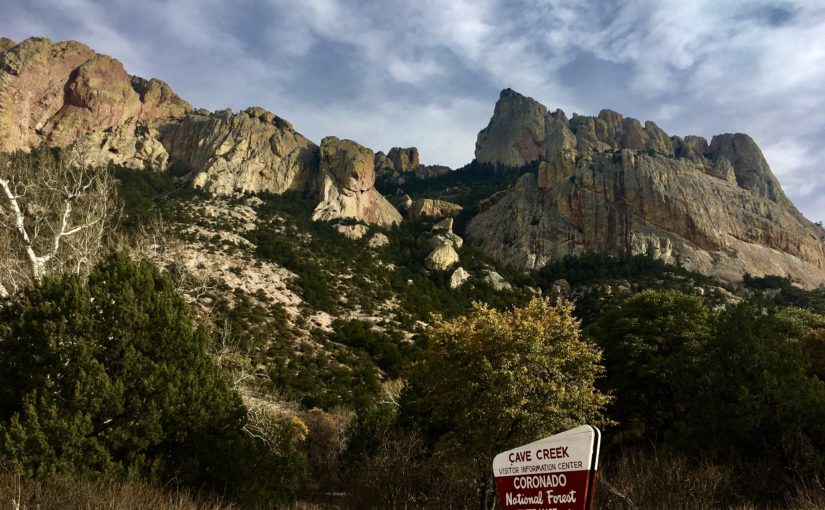
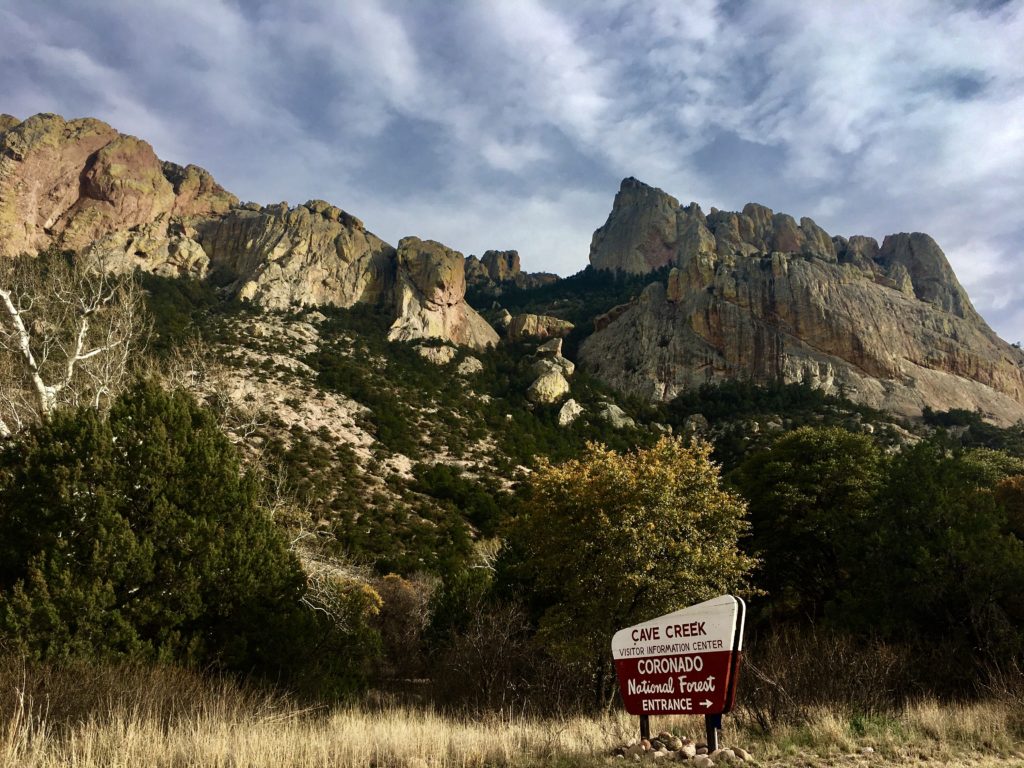


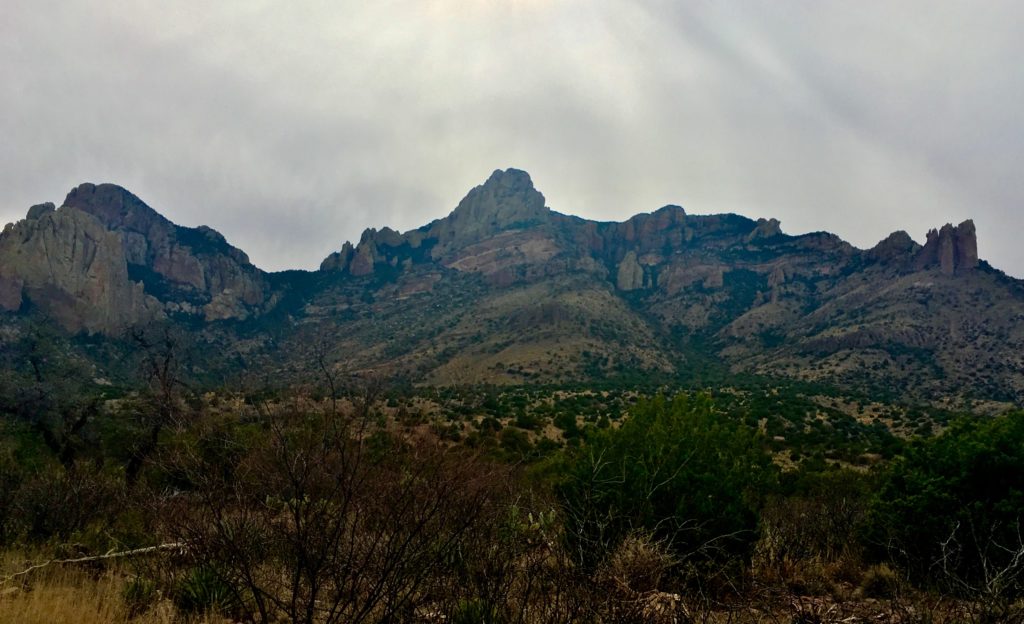
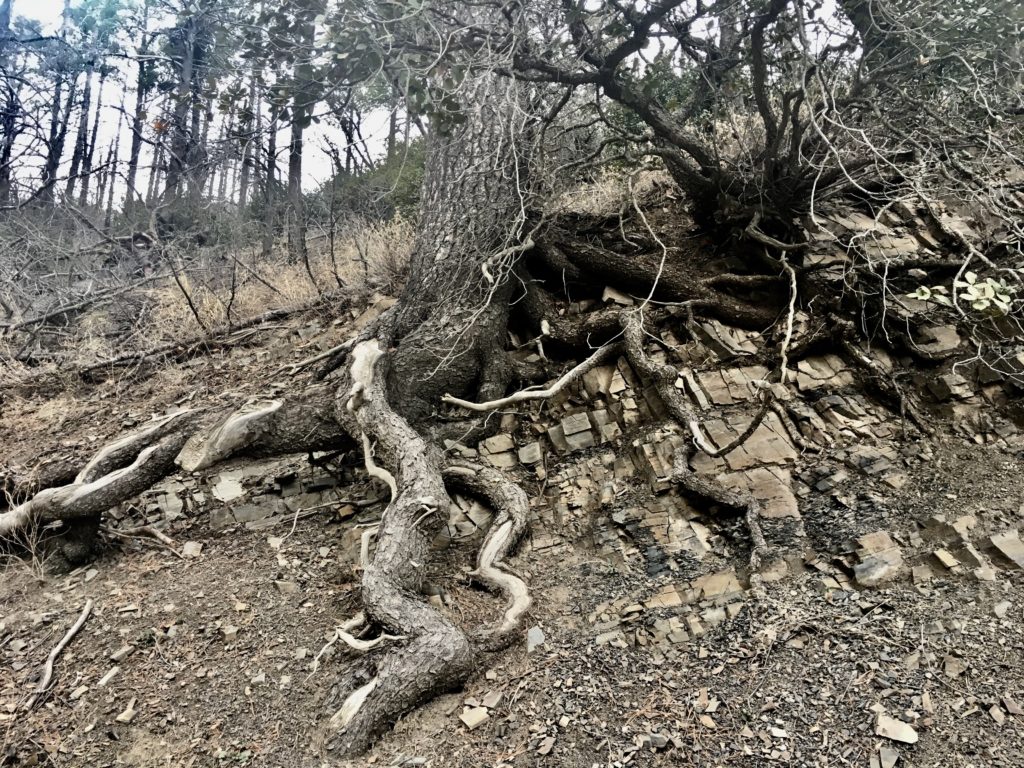
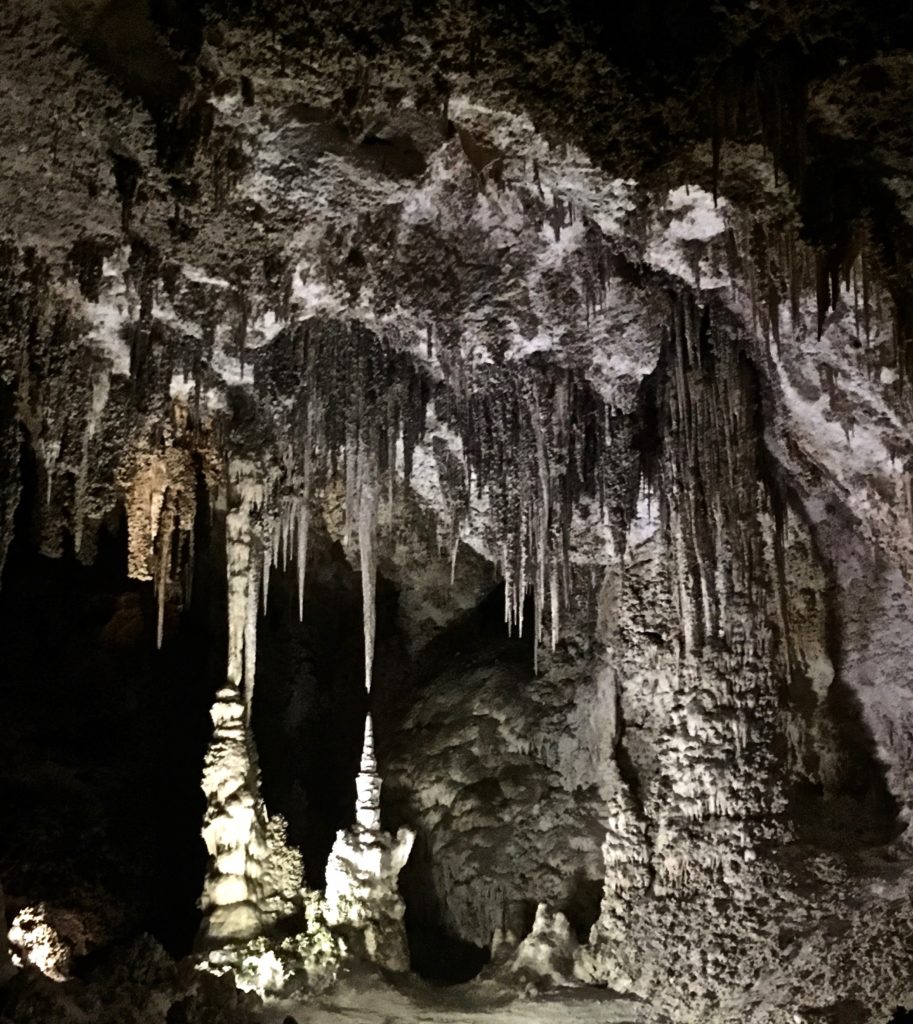


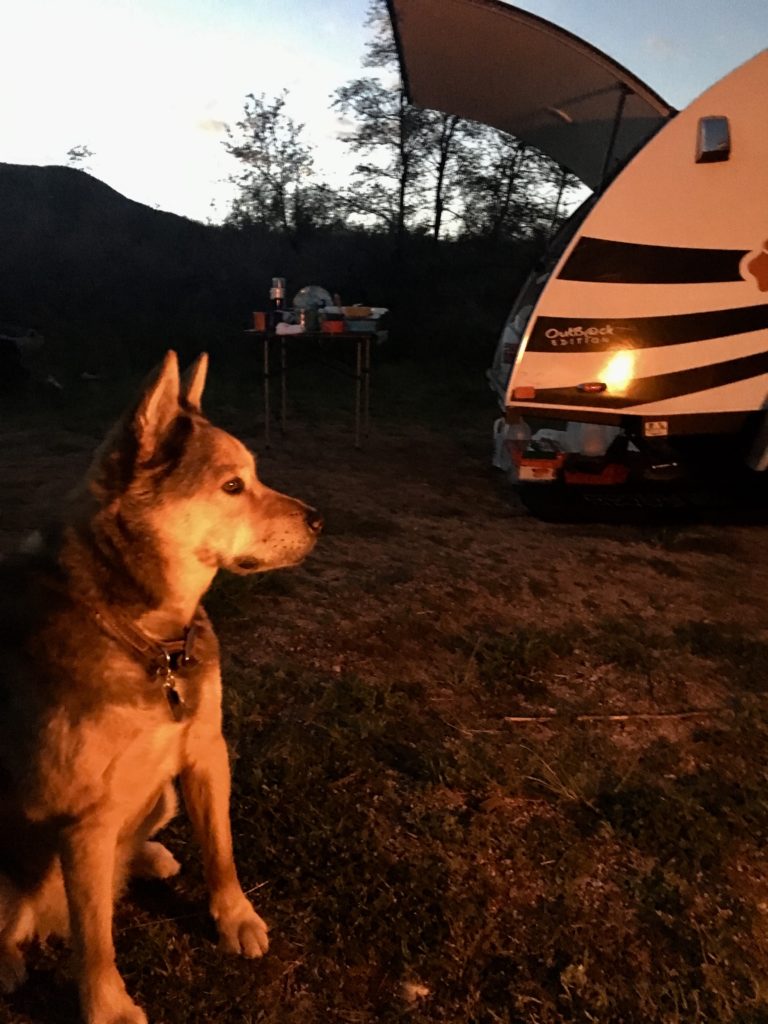
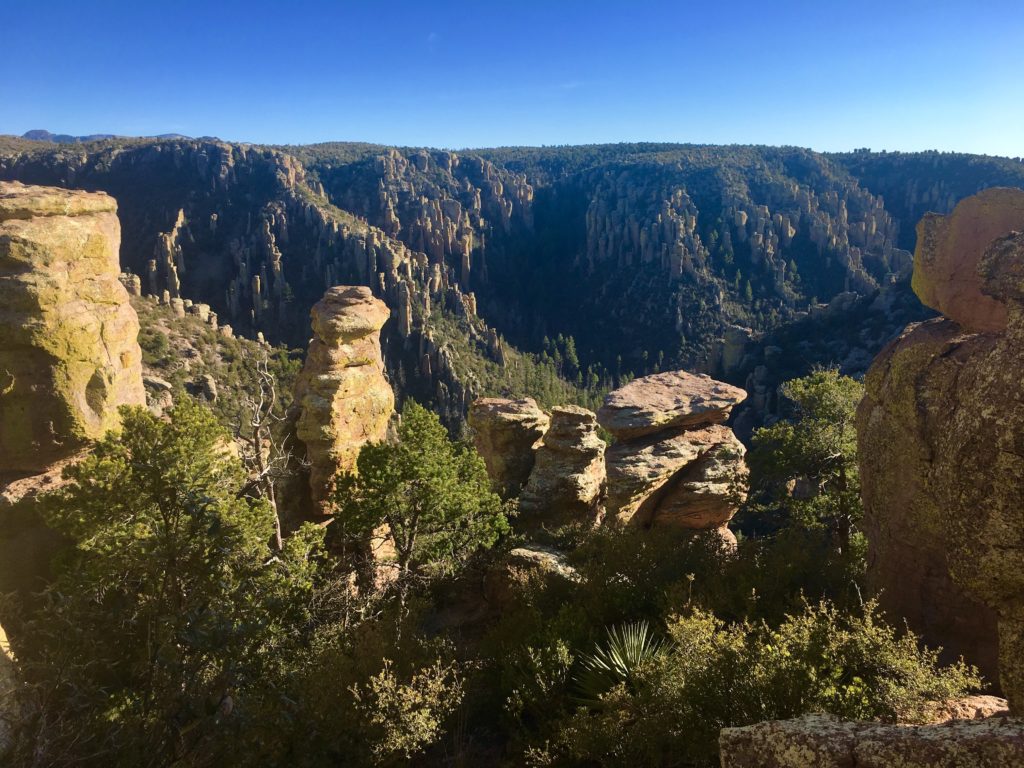


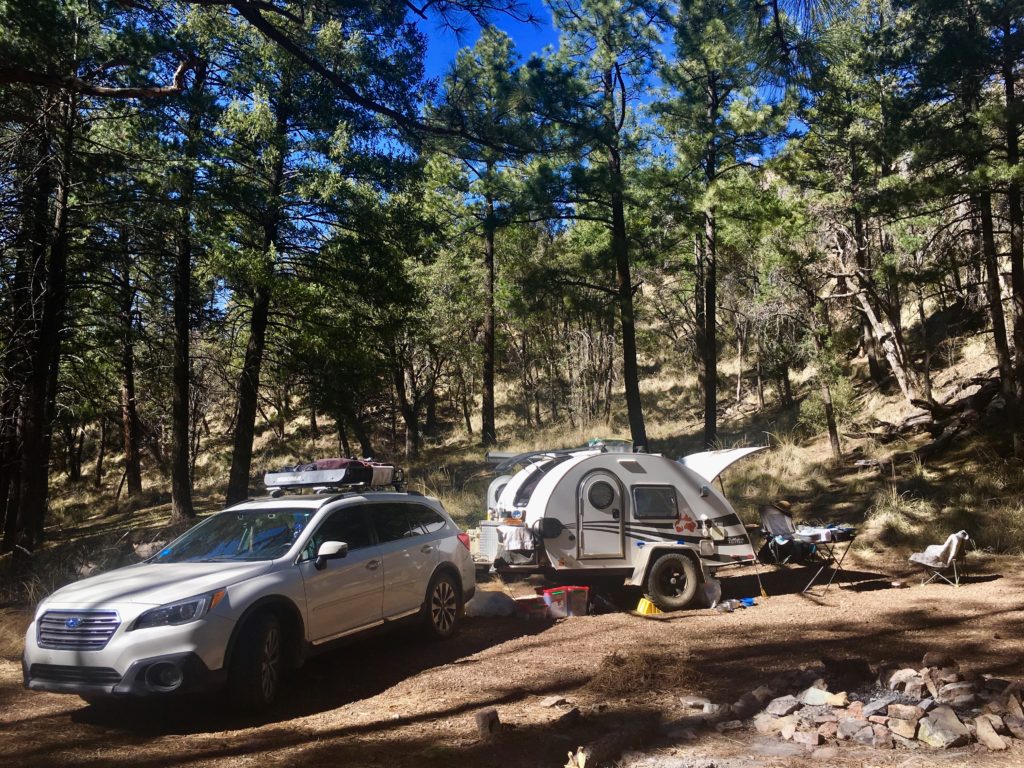

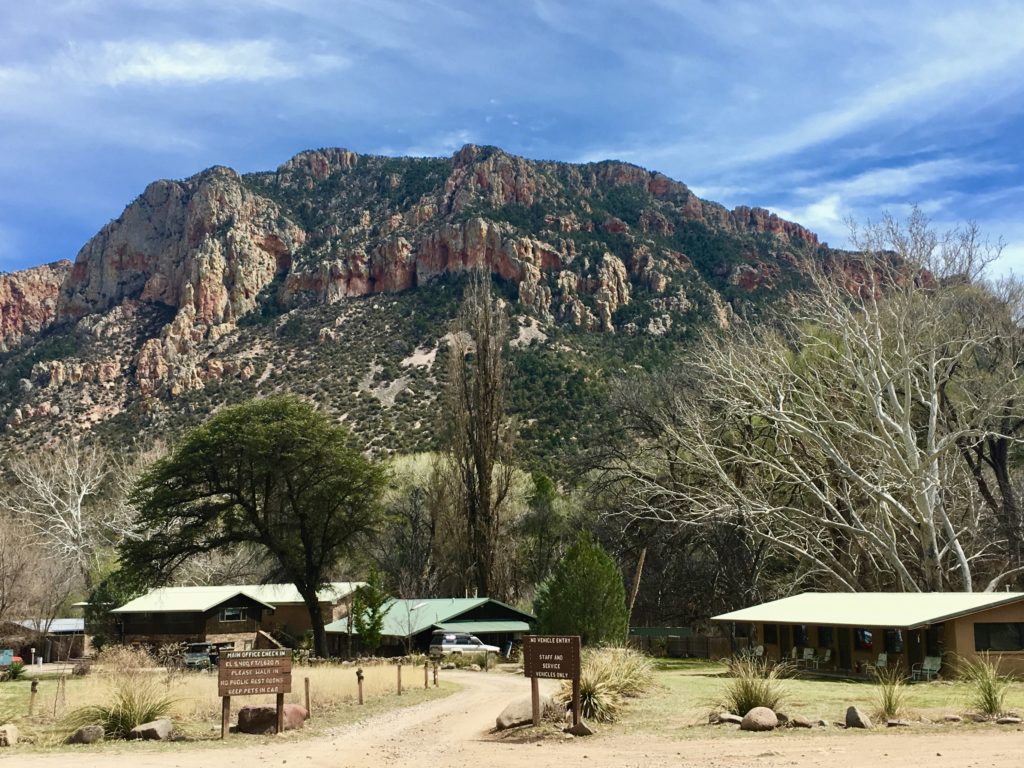
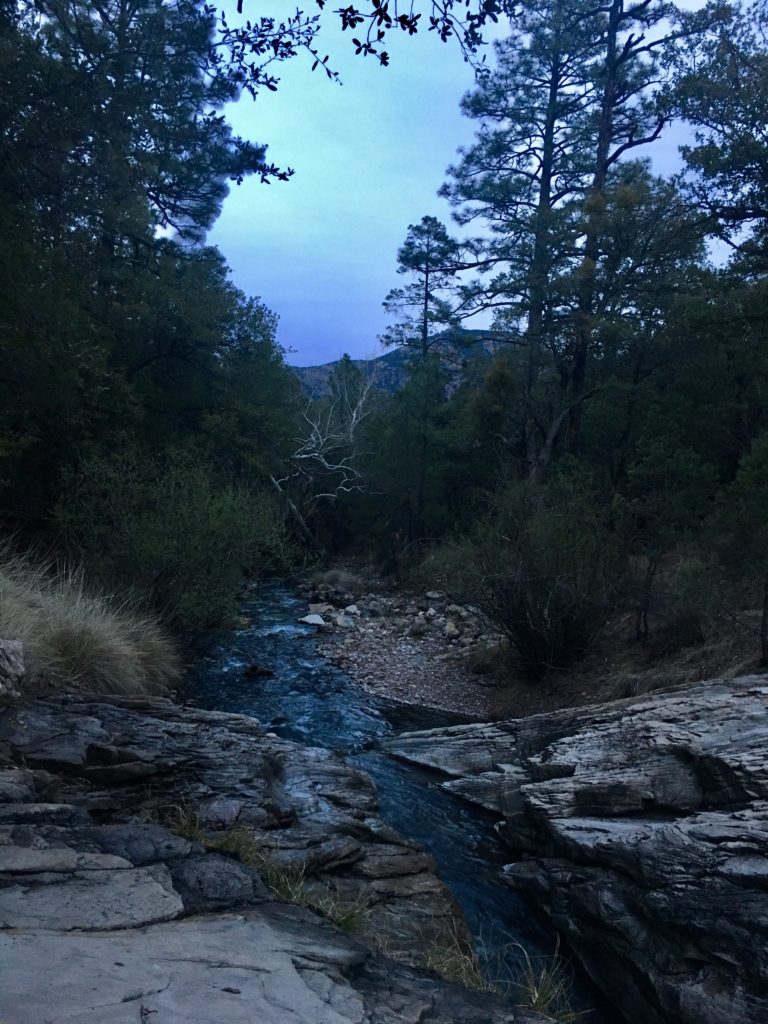


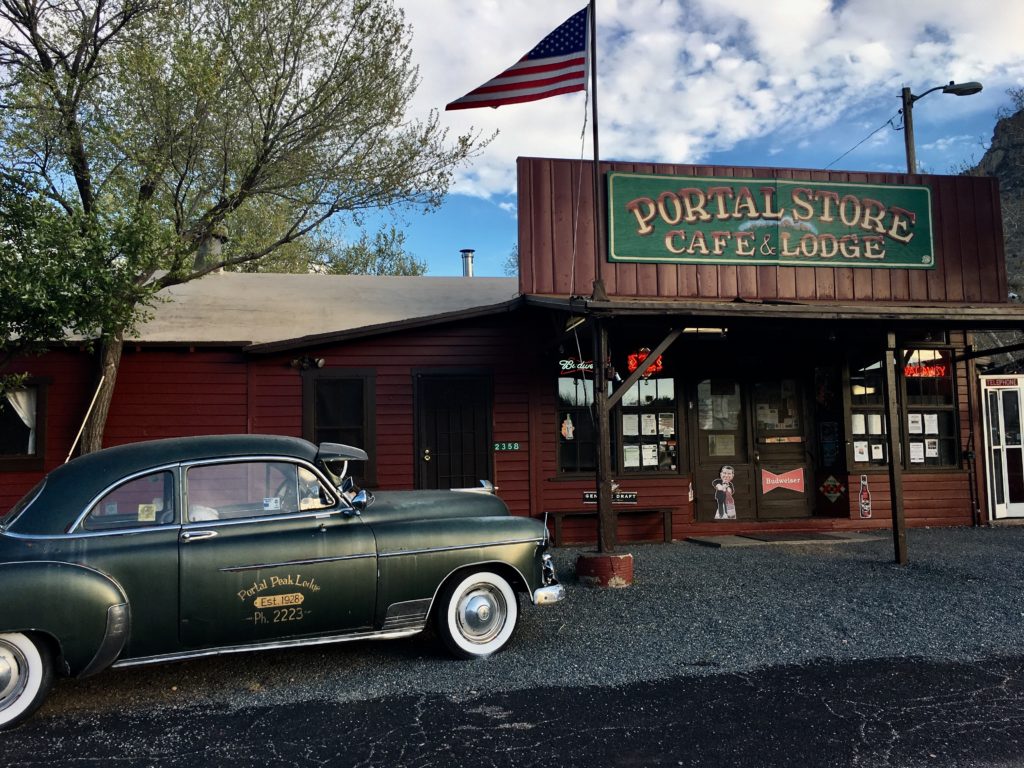
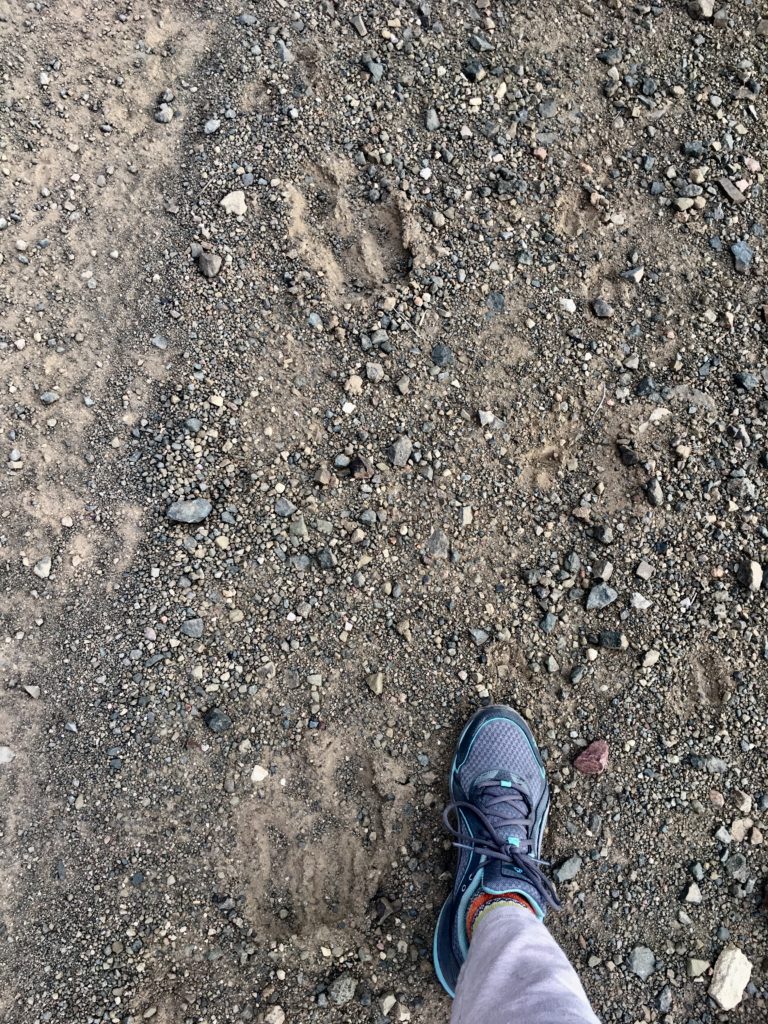
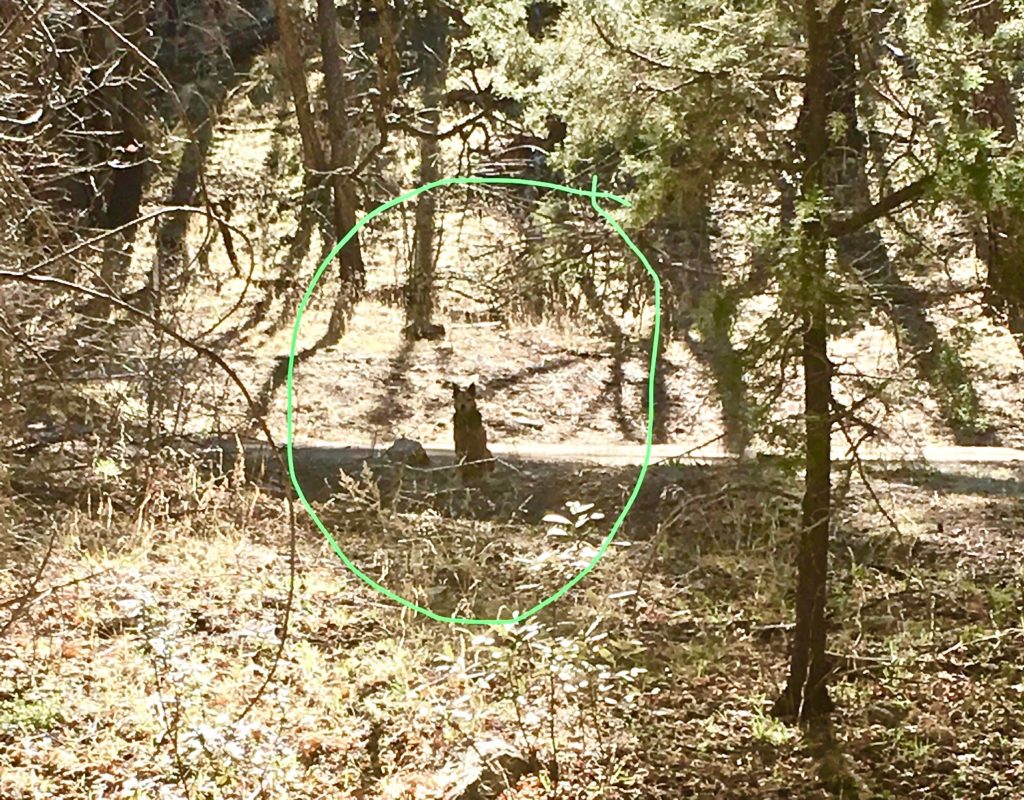



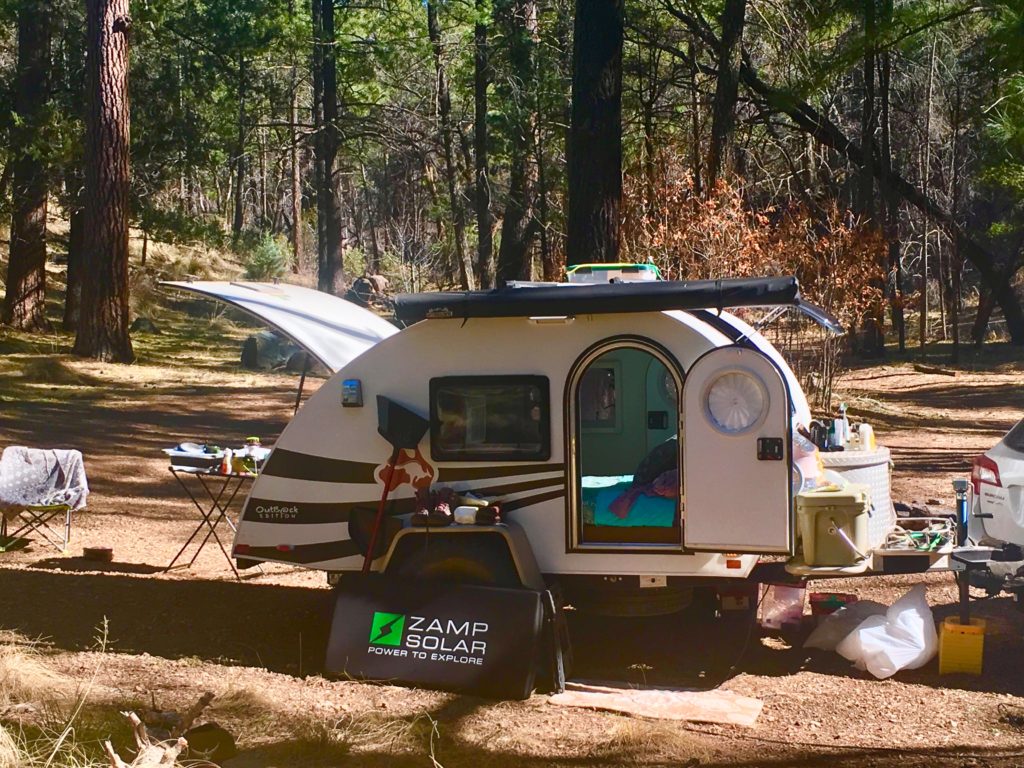

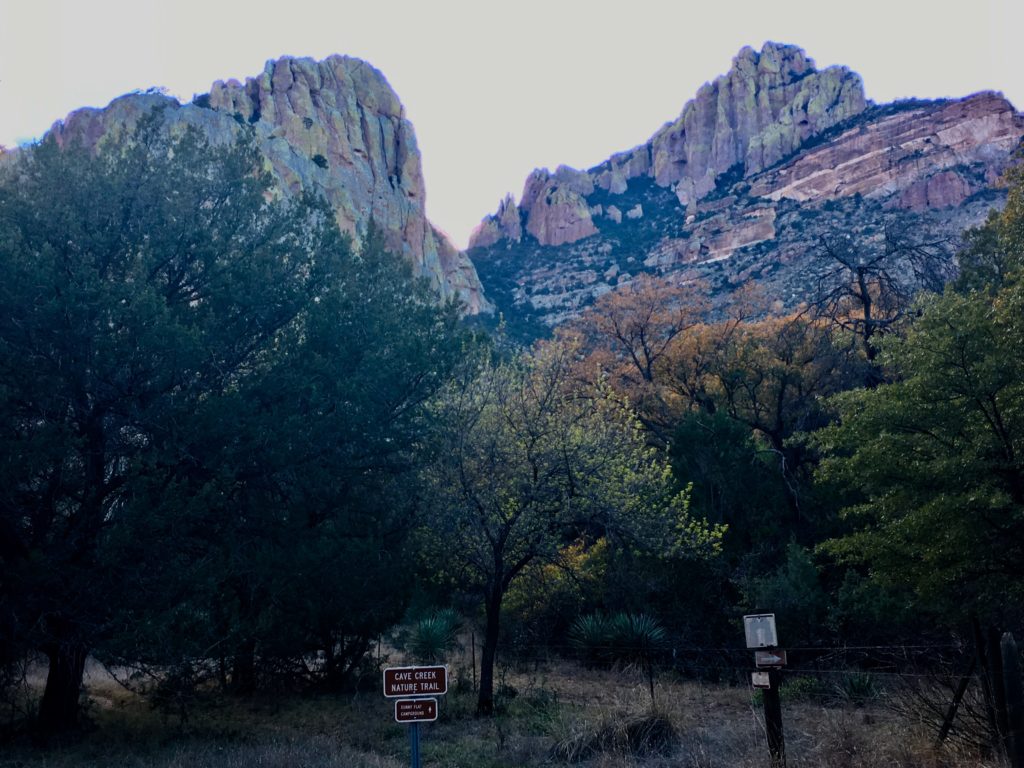

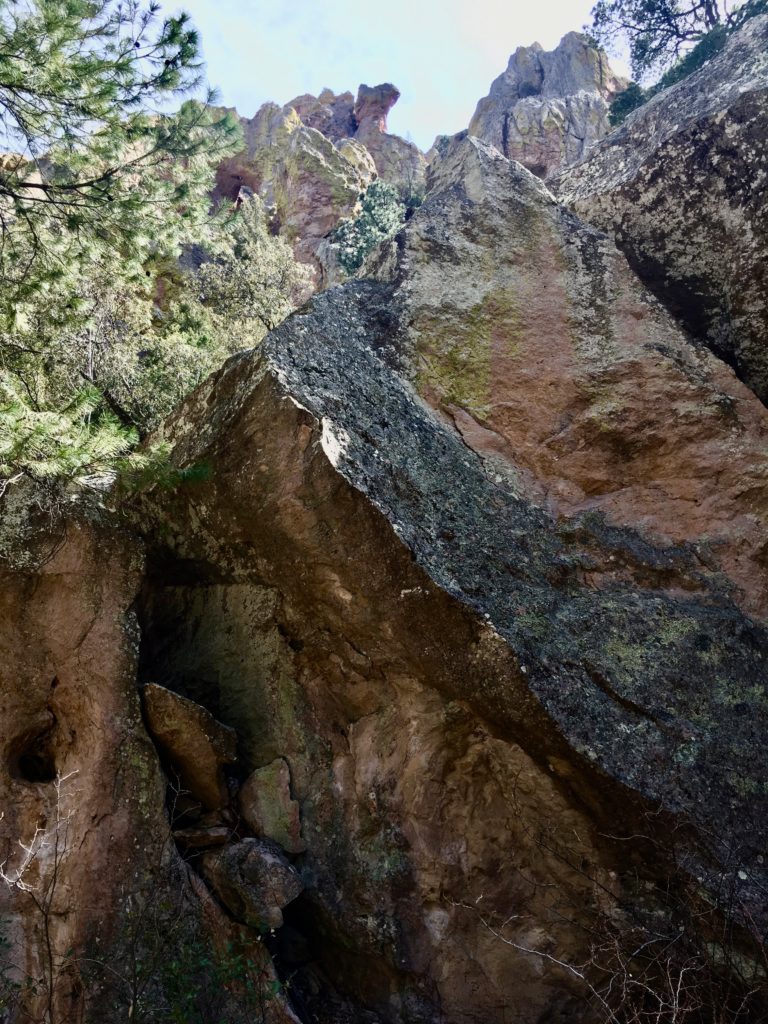
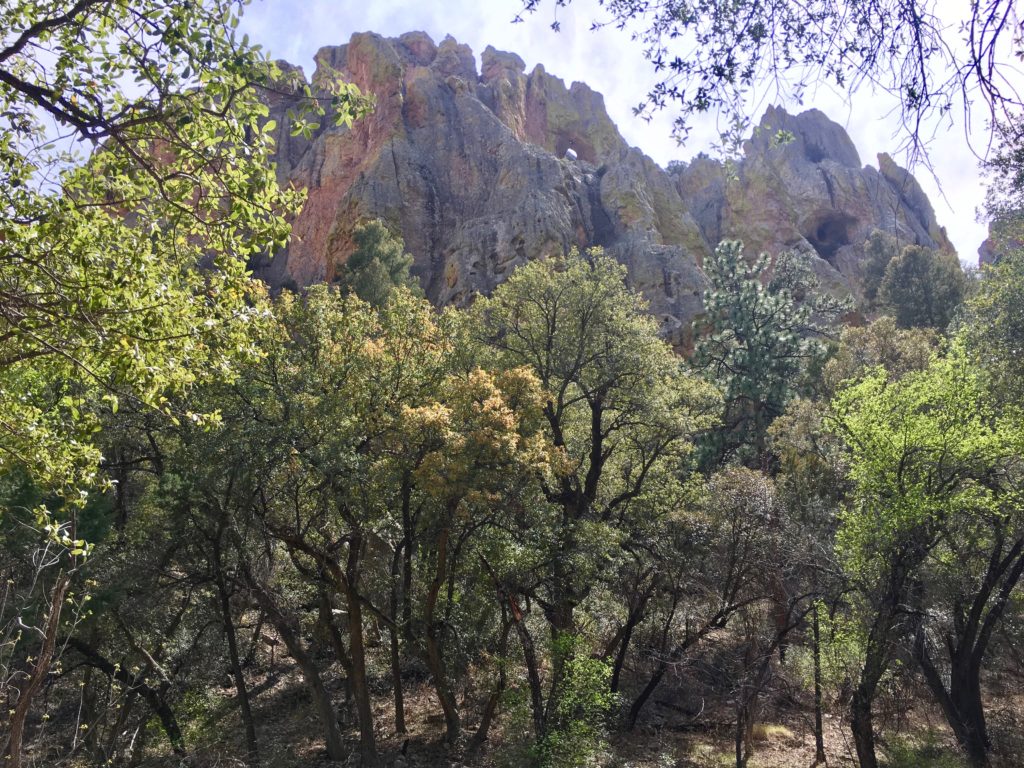

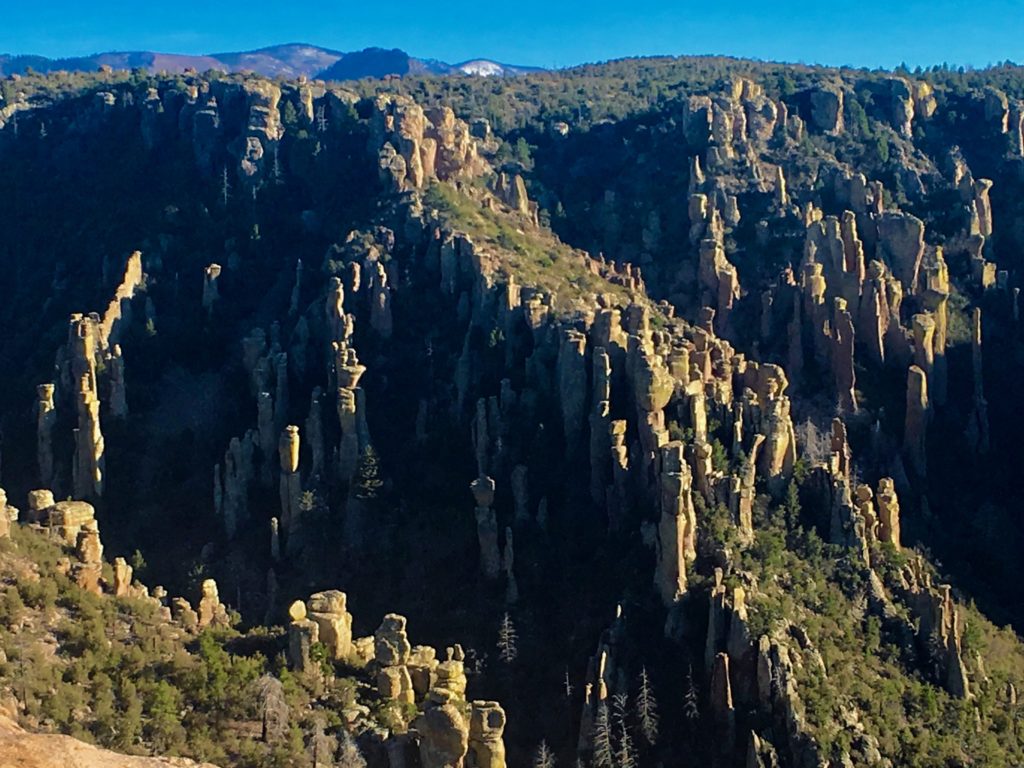
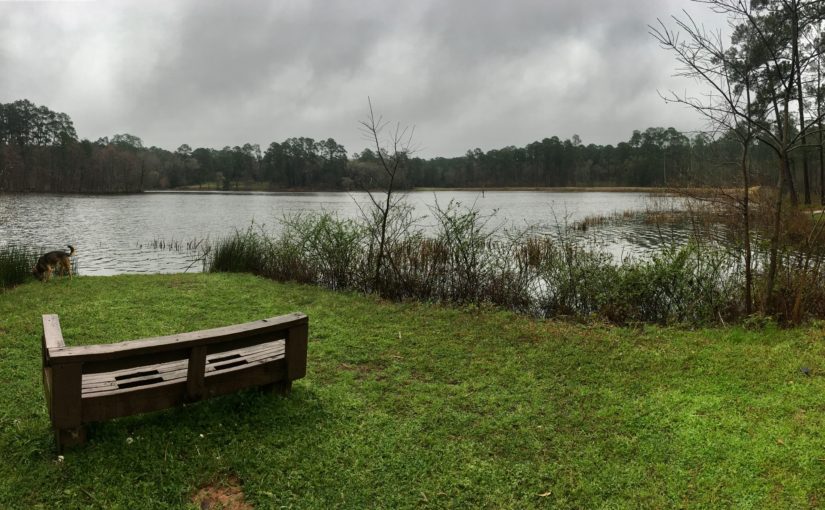
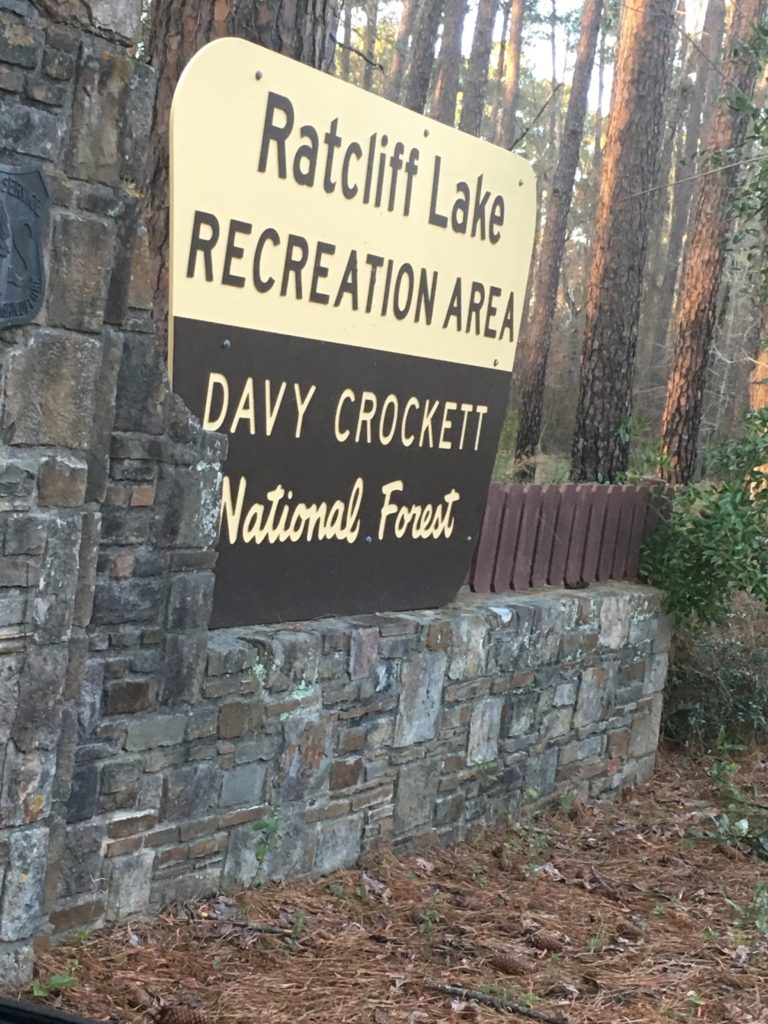
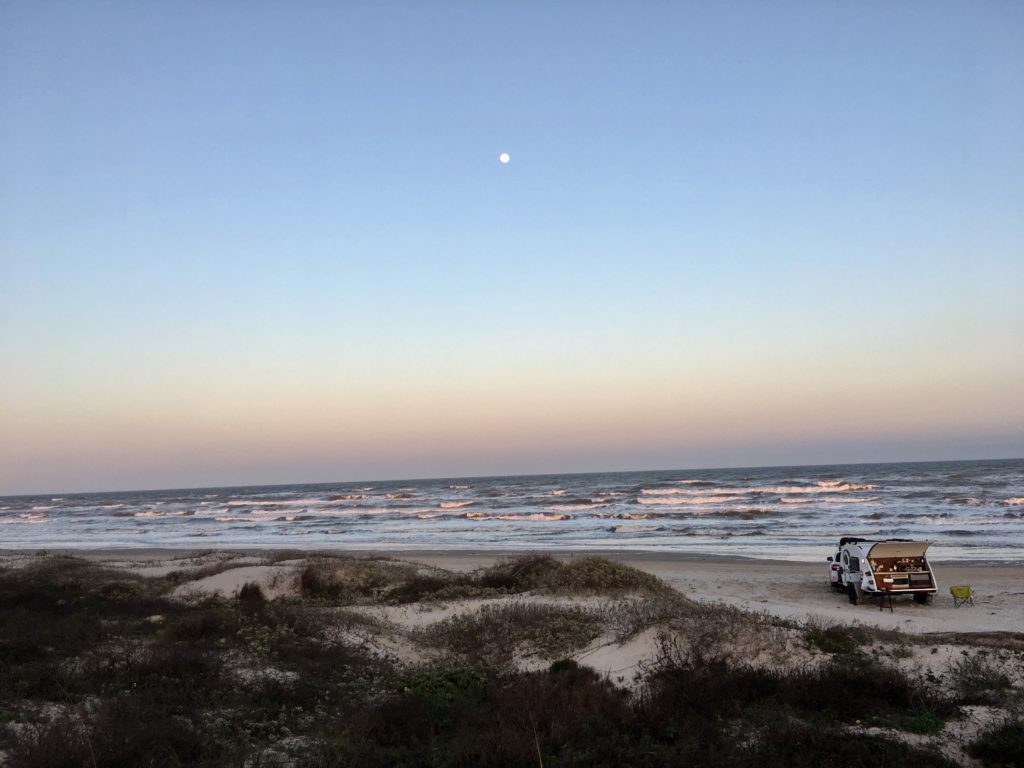

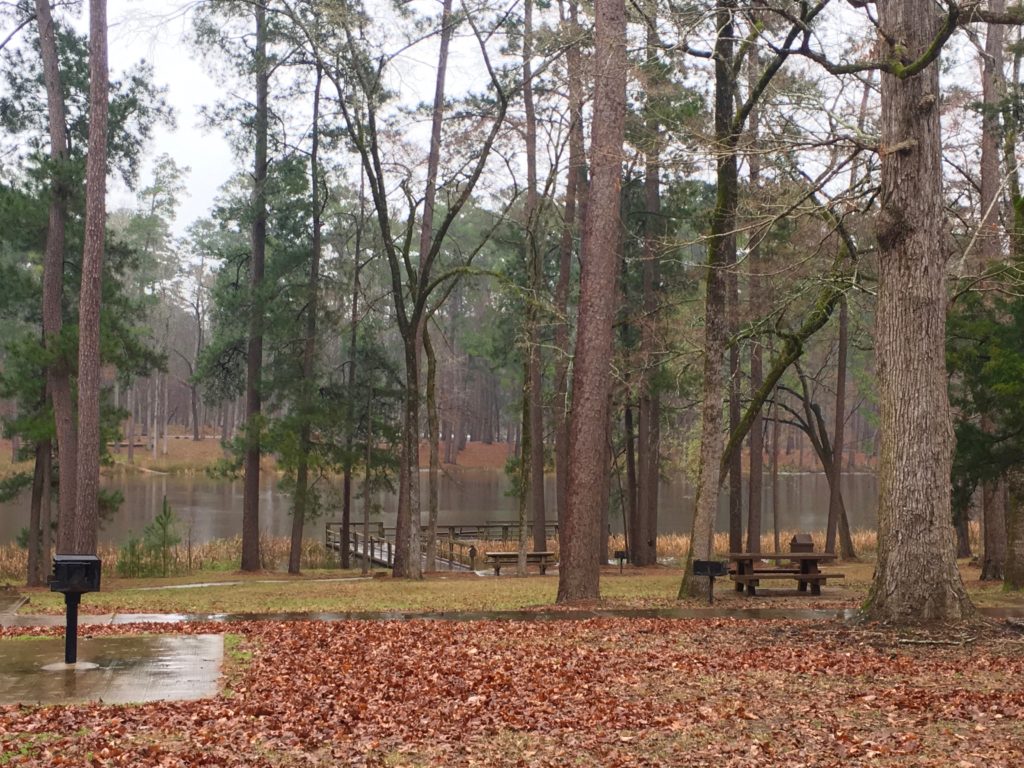


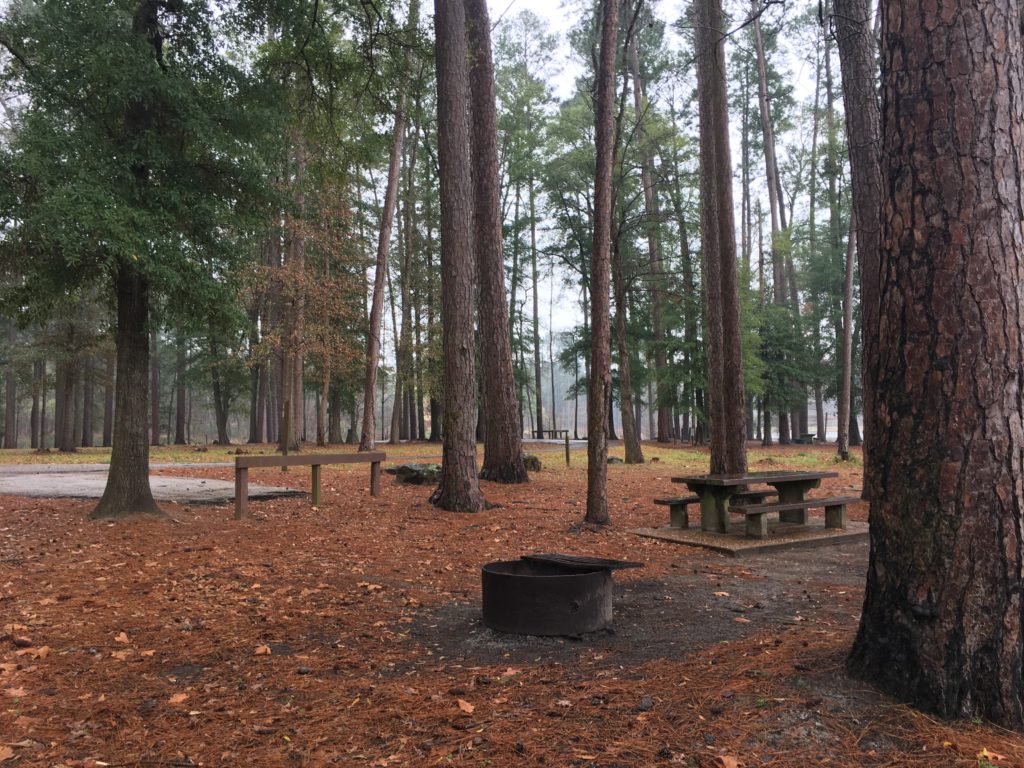


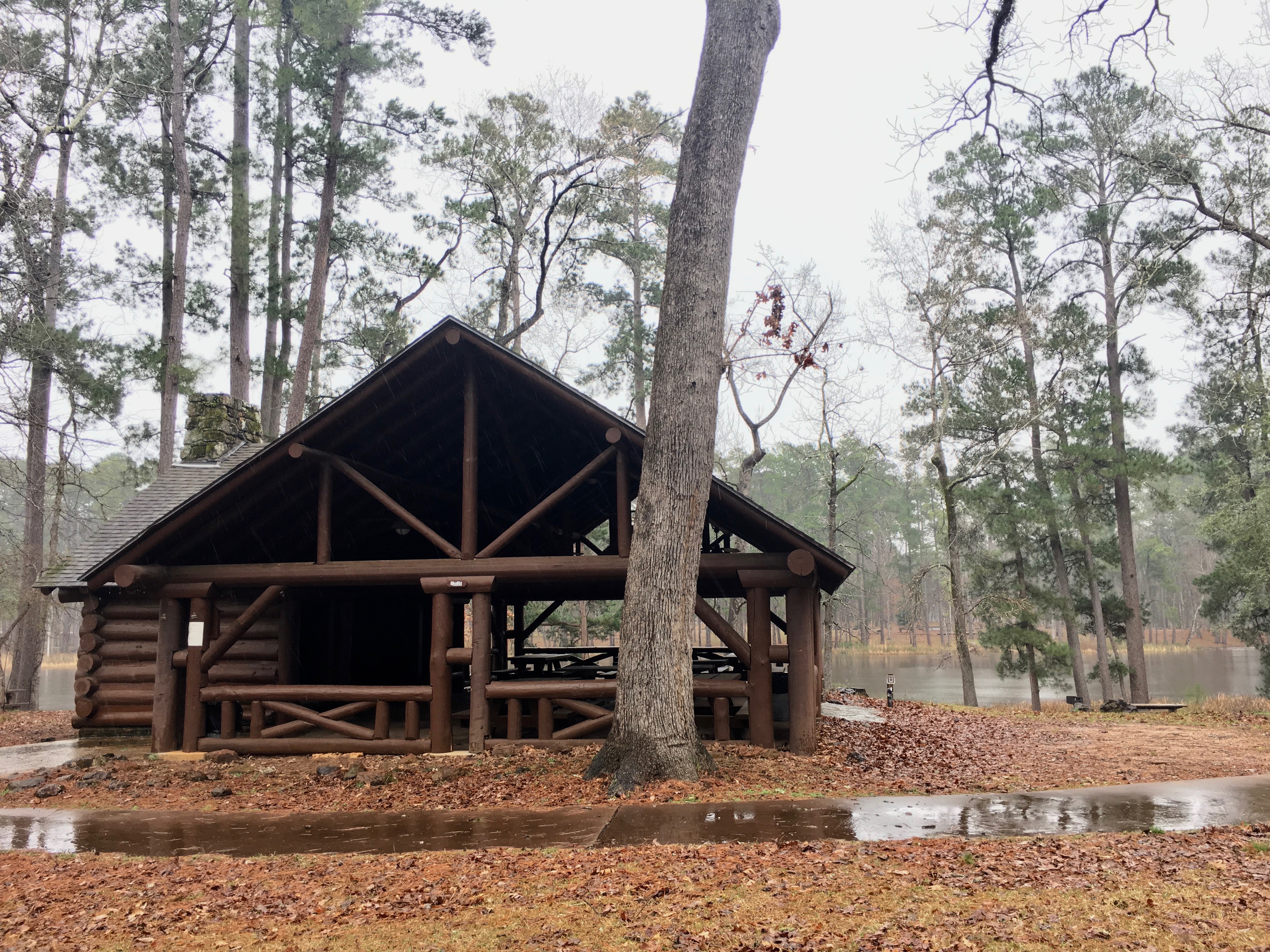




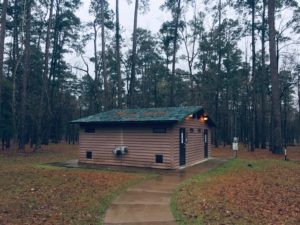
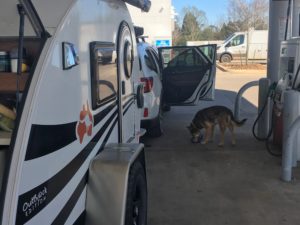

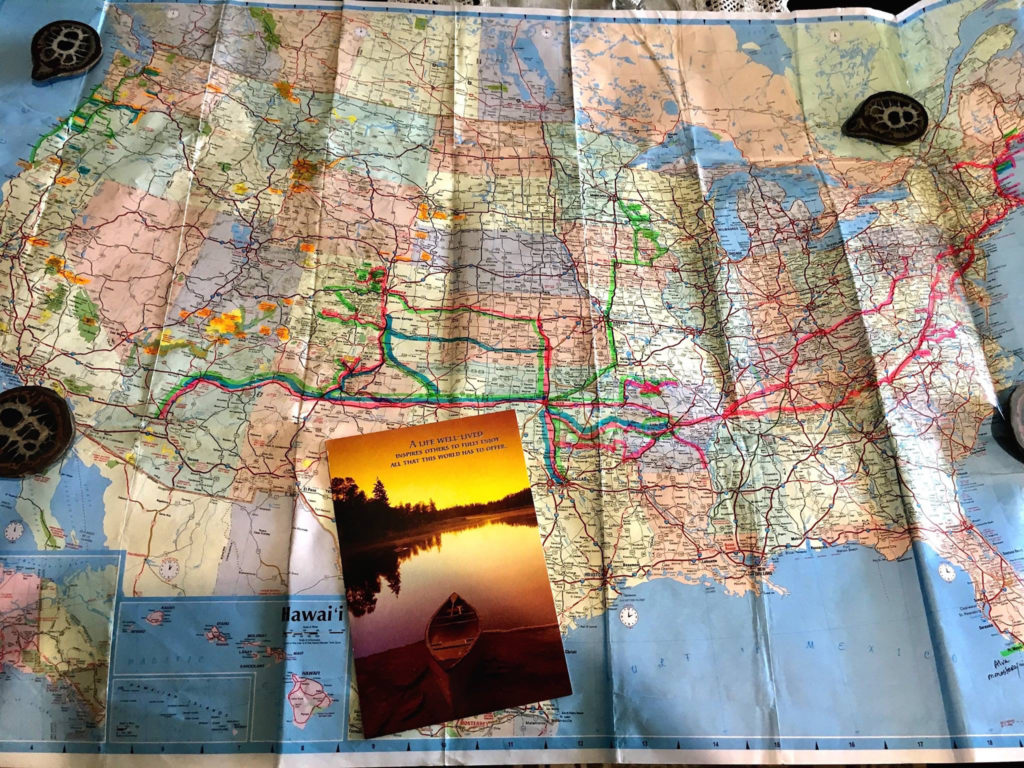
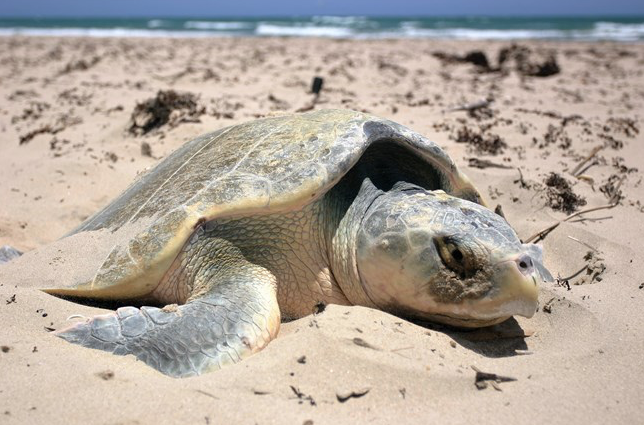

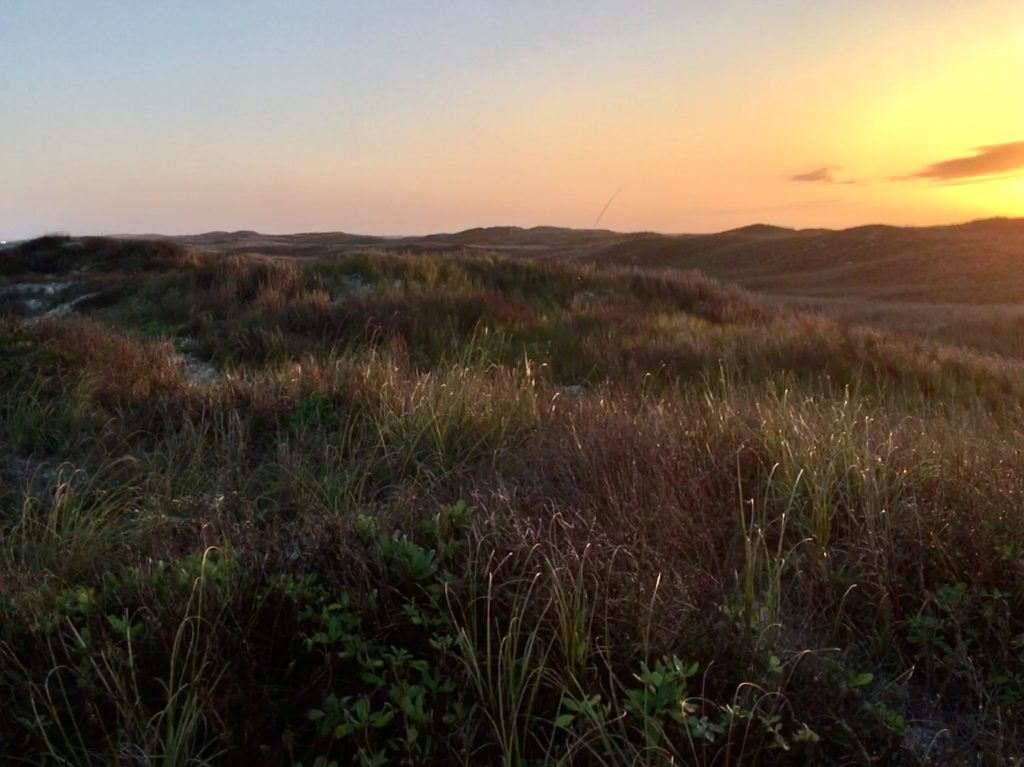
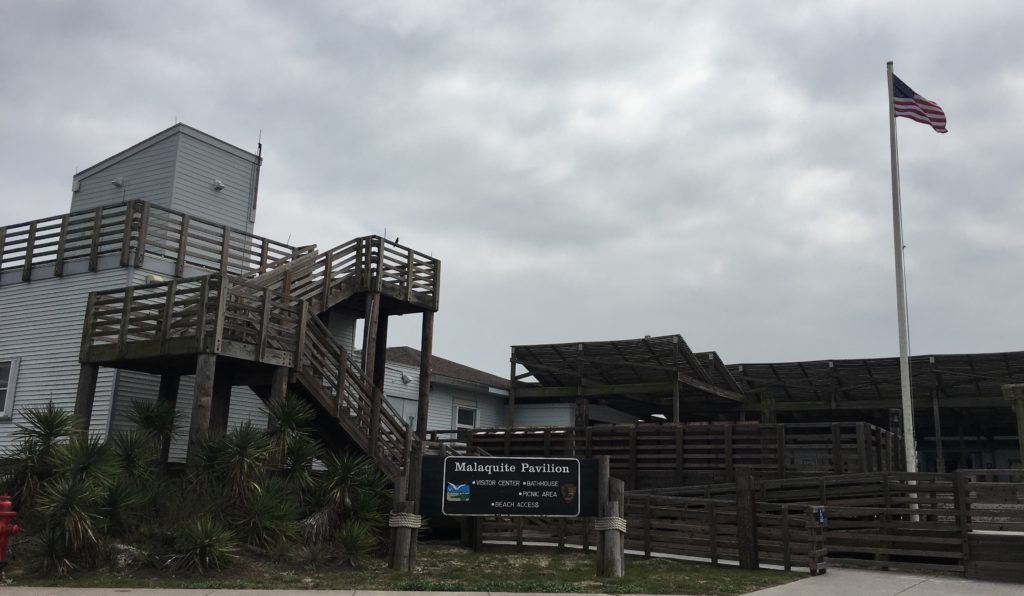
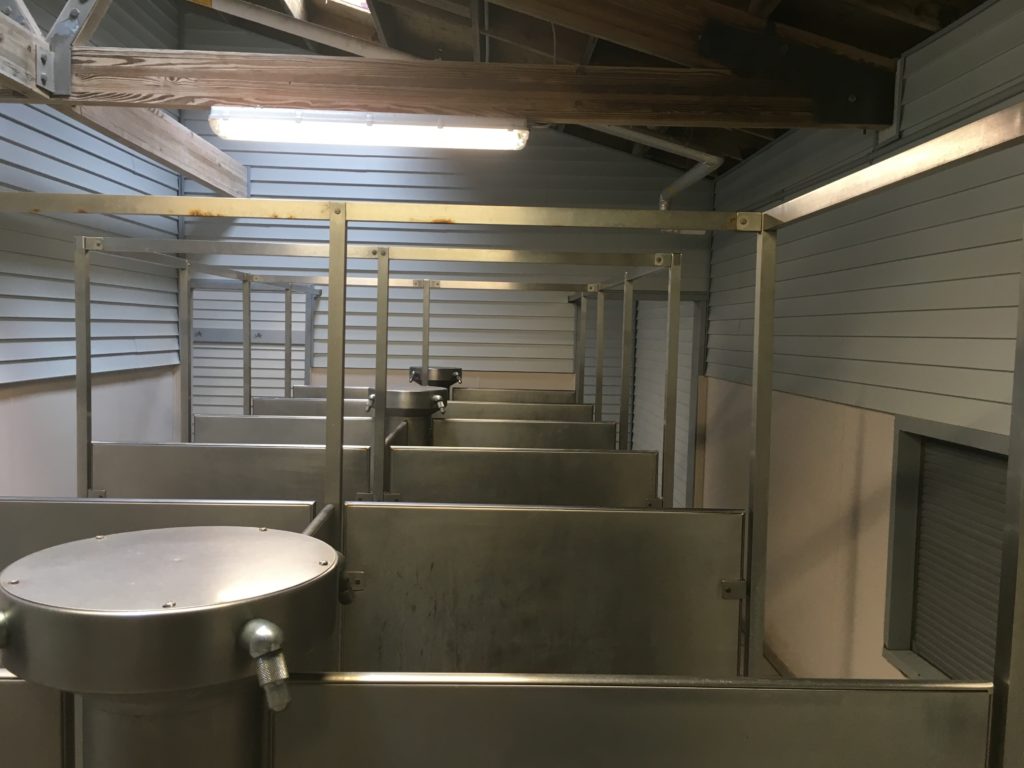
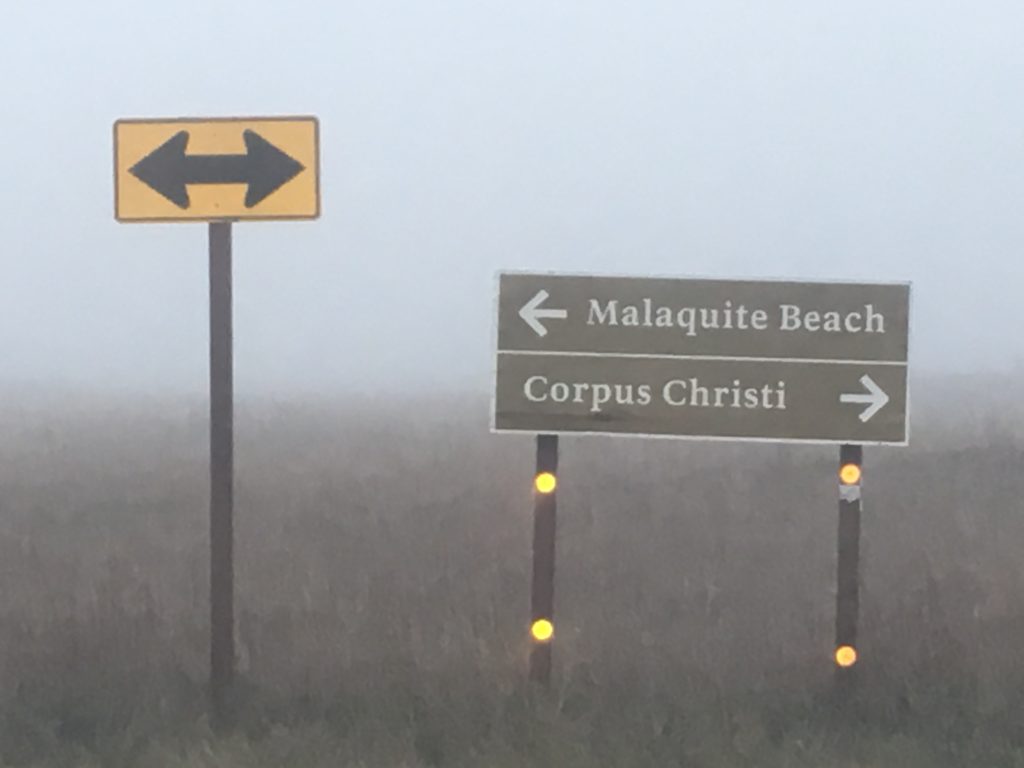
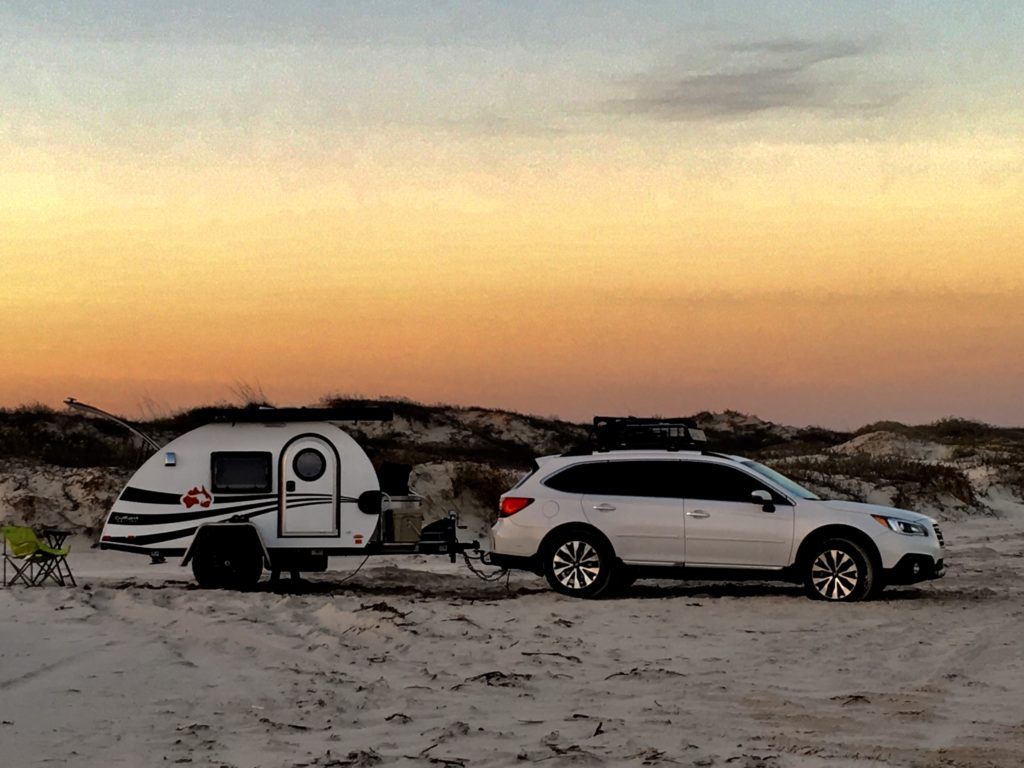
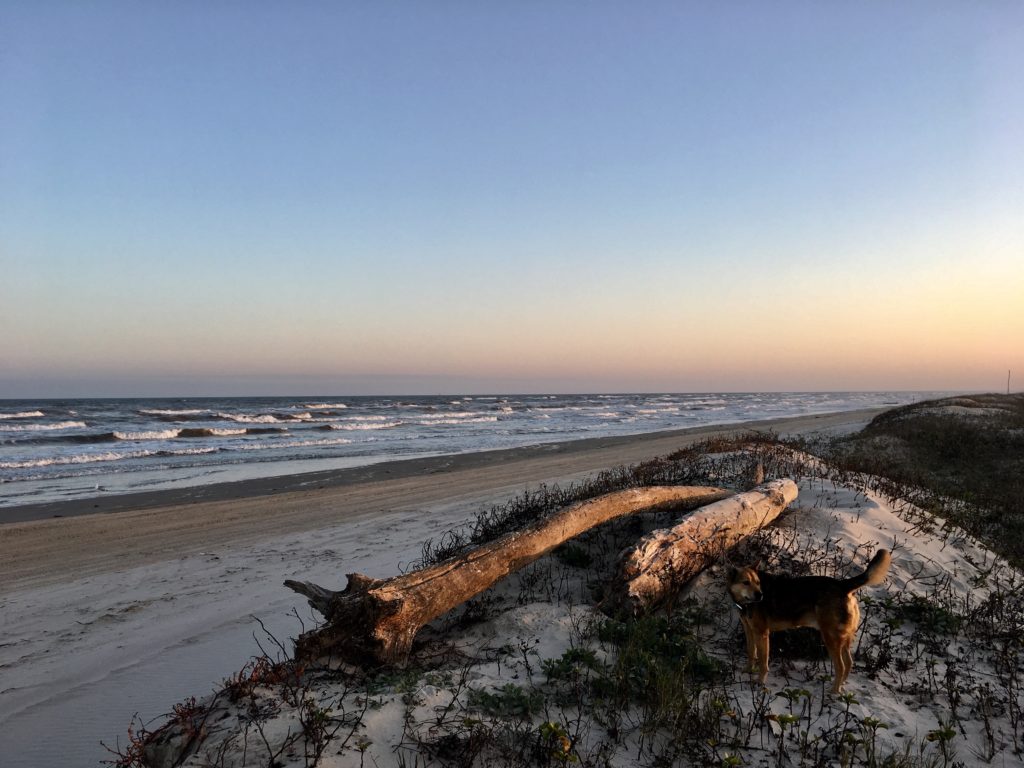
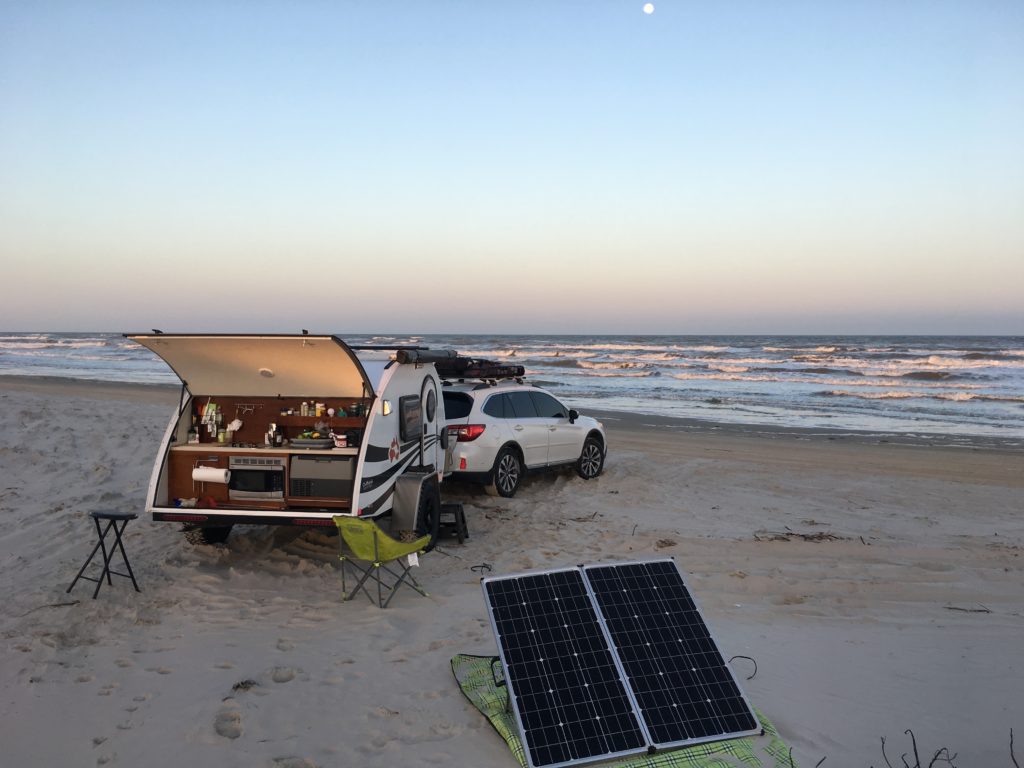

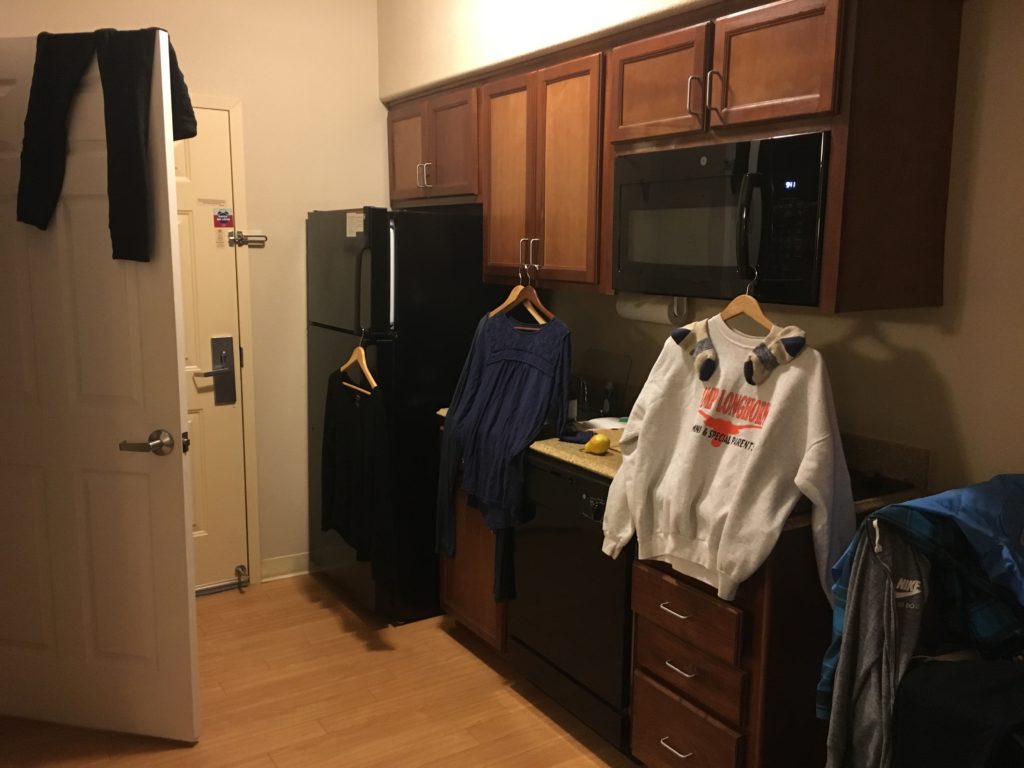

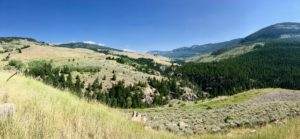
 impact seemed to be loss of Eyesight system that’s the “
impact seemed to be loss of Eyesight system that’s the “ I arrived late in the day to the remote, mountaintop Upper
I arrived late in the day to the remote, mountaintop Upper 
 Retired from a life of rodeos and barebacking Corky is a true cowboy with powerful, rugged features, good manners, and a helping hand if needed. He popped out of nowhere to assist my trailer backing before building a warm fire while I set up camp.
Retired from a life of rodeos and barebacking Corky is a true cowboy with powerful, rugged features, good manners, and a helping hand if needed. He popped out of nowhere to assist my trailer backing before building a warm fire while I set up camp. I don’t do campfires in the west because of fire hazards and I’m lazy. I know the tending required to have a safe fire and I’ll not risk a forest fire for food and warmth unless absolutely necessary. I have a propane stove to cook and a dog for cold toes.
I don’t do campfires in the west because of fire hazards and I’m lazy. I know the tending required to have a safe fire and I’ll not risk a forest fire for food and warmth unless absolutely necessary. I have a propane stove to cook and a dog for cold toes.

 You have to want it to get it. Take HW 14 east out of Shell, Wyoming for 17 miles through the Scenic Big Horn Highway then exit forest road 17 and go south 24.5 miles. Plan on two hours to drive that short 24 mile distance through some of the country’s most inspiring offroad vistas. There’s no cell or tow service.
You have to want it to get it. Take HW 14 east out of Shell, Wyoming for 17 miles through the Scenic Big Horn Highway then exit forest road 17 and go south 24.5 miles. Plan on two hours to drive that short 24 mile distance through some of the country’s most inspiring offroad vistas. There’s no cell or tow service. It always baffled me that herds calmly move to a cowboy’s request. Not anymore. I’m far too independent for herds but being looked after by somebody who takes his job seriously in the sometimes perilous outback is a gift I gratefully accepted. So did Rocky.
It always baffled me that herds calmly move to a cowboy’s request. Not anymore. I’m far too independent for herds but being looked after by somebody who takes his job seriously in the sometimes perilous outback is a gift I gratefully accepted. So did Rocky. My extensive travel does not have nor require a big budget. Paid lodging is a rare treat strictly reserved for a hot soak in a deep tub, laundry, and supplies. The anxiety over these unexpected expenses has been eased by the miracle of the folks crossing my path like family friend AJ and her Indian Gulch Ranch. It reminds me that everything works out better than I could imagine if I just stay in the flow.
My extensive travel does not have nor require a big budget. Paid lodging is a rare treat strictly reserved for a hot soak in a deep tub, laundry, and supplies. The anxiety over these unexpected expenses has been eased by the miracle of the folks crossing my path like family friend AJ and her Indian Gulch Ranch. It reminds me that everything works out better than I could imagine if I just stay in the flow. Kathy at
Kathy at 

 Watching Rob work the boat into just the right spot then hold it in the current so my line would sweep perfectly through a drift was impressive. Nothing to write home about in size but plenty of action with the small, less experienced fish.
Watching Rob work the boat into just the right spot then hold it in the current so my line would sweep perfectly through a drift was impressive. Nothing to write home about in size but plenty of action with the small, less experienced fish. yearned for the smaller streams and relaxed ease of outback fly fishing where larger fish are more likely to play.
yearned for the smaller streams and relaxed ease of outback fly fishing where larger fish are more likely to play. Rocky and I picnicked at a boondock site an hour off HW 287 on FR 202 of the West Fork of the Madison. We spied the shallow, swift water sweeping beside the small pine meadow in a valley just when hunger couldn’t be denied any longer.
Rocky and I picnicked at a boondock site an hour off HW 287 on FR 202 of the West Fork of the Madison. We spied the shallow, swift water sweeping beside the small pine meadow in a valley just when hunger couldn’t be denied any longer. to scout a campsite nearby and had come off the mountain at dawn with big plans to celebrate his first anniversary with his new bride and their young son.
to scout a campsite nearby and had come off the mountain at dawn with big plans to celebrate his first anniversary with his new bride and their young son. An hour or so on down the road a cyclist was stopped and I slowed to confirm he and his retro 1970’s Harley were ok. A bit later I moved on with even more secret fishing spots in the gorgeous “Chain of Lakes” and smaller West Fork scribbled in my notebook. Unfortunately there was not nearly enough daylight to keep going especially when I was nearing the end of my week near Ennis, Montana and my car still wasn’t ready.
An hour or so on down the road a cyclist was stopped and I slowed to confirm he and his retro 1970’s Harley were ok. A bit later I moved on with even more secret fishing spots in the gorgeous “Chain of Lakes” and smaller West Fork scribbled in my notebook. Unfortunately there was not nearly enough daylight to keep going especially when I was nearing the end of my week near Ennis, Montana and my car still wasn’t ready. Madison Management Kathy stepped in once again and knocked it out of the park with a cabin very much like the boondocking sites I love the most. Behind a locked cattle gate on a wild pristine stretch of the Madison River with a side stream enveloping a small
Madison Management Kathy stepped in once again and knocked it out of the park with a cabin very much like the boondocking sites I love the most. Behind a locked cattle gate on a wild pristine stretch of the Madison River with a side stream enveloping a small island the cabin and the imprints of lives well lived raised the hair on my body in a most pleasing way.
island the cabin and the imprints of lives well lived raised the hair on my body in a most pleasing way.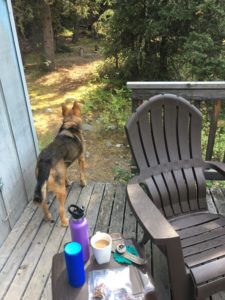 The first two days Rocky guarded every exit from the house sticking right by my side even when I walked to the car. He’s had enough outback experience to know we stick together with this much wildlife around.
The first two days Rocky guarded every exit from the house sticking right by my side even when I walked to the car. He’s had enough outback experience to know we stick together with this much wildlife around. By the third day we had explored every inch of land and water in this enchanted stretch. In fact, the week we were there we never left the property, never unlocked the gate, and never once had a desire for any part of life beyond the gate.
By the third day we had explored every inch of land and water in this enchanted stretch. In fact, the week we were there we never left the property, never unlocked the gate, and never once had a desire for any part of life beyond the gate. Montana believes water is public so there’s none of that blocked access to private waters nonsense you find in other states. Every couple of days a savvy fly fisher would wade up the back side of the island where the slower stream flows in front of the cabin and I could get a fishing report to compare to my own.
Montana believes water is public so there’s none of that blocked access to private waters nonsense you find in other states. Every couple of days a savvy fly fisher would wade up the back side of the island where the slower stream flows in front of the cabin and I could get a fishing report to compare to my own. I also had an extraordinary visit with the woman who grew up on this stretch and raised her kids there too. Kindred spirits we both know how priceless a small stretch of outback fresh, cold water can be for generations of family and friends. I cherish that visit and her amazing rosemary pear preserves.
I also had an extraordinary visit with the woman who grew up on this stretch and raised her kids there too. Kindred spirits we both know how priceless a small stretch of outback fresh, cold water can be for generations of family and friends. I cherish that visit and her amazing rosemary pear preserves. I marvel at what we’ve had access to since we left Minneapolis in August. I sense watery images of what awaits us in the secret places we’ve yet to explore.
I marvel at what we’ve had access to since we left Minneapolis in August. I sense watery images of what awaits us in the secret places we’ve yet to explore. My heart and my budget need my rig back. I’m questioning the wisdom of Subaru playing a leading role in my outback, offgrid life. Looks good in the commercials but at just over 30,000 miles my reliability and service experience is taking a huge hit by sitting in the shop for a month. That breaks a bottom line survival rule for a solo, outback, offgrid nomad and her dog and smells an awful lot like a lemon.
My heart and my budget need my rig back. I’m questioning the wisdom of Subaru playing a leading role in my outback, offgrid life. Looks good in the commercials but at just over 30,000 miles my reliability and service experience is taking a huge hit by sitting in the shop for a month. That breaks a bottom line survival rule for a solo, outback, offgrid nomad and her dog and smells an awful lot like a lemon.

 raspberry meadow on the roaring creek in the shadow of Crystal Peak outside Hill City, South Dakota. But I respect the other wanderers who fill the places I free up, so I sang travel songs and prayers into my pack and headed north to Big Horn country.
raspberry meadow on the roaring creek in the shadow of Crystal Peak outside Hill City, South Dakota. But I respect the other wanderers who fill the places I free up, so I sang travel songs and prayers into my pack and headed north to Big Horn country. grow deeper, faster, longer. Twenty square acres can offer snow-capped mountains, hills rolling into wide prairie valleys dropping to canyons laced with crystal streams, waterfalls, and roaring rivers. The entire universe can exist in one alluring square inch.
grow deeper, faster, longer. Twenty square acres can offer snow-capped mountains, hills rolling into wide prairie valleys dropping to canyons laced with crystal streams, waterfalls, and roaring rivers. The entire universe can exist in one alluring square inch. There is also comfort in the northwest summer temperatures. Unlike the South’s wet sweat lodge heat, it’s quite simple to find cooling shade in the northern trees and bluffs. A nearby icy creek, river, or lake can relieve even the worst heat of the day and evening breezes bring the perfect chill for snuggling in.
There is also comfort in the northwest summer temperatures. Unlike the South’s wet sweat lodge heat, it’s quite simple to find cooling shade in the northern trees and bluffs. A nearby icy creek, river, or lake can relieve even the worst heat of the day and evening breezes bring the perfect chill for snuggling in. Social and sacred gathering sites like Medicine Lodge outside Hyattville, WY invoke feelings of going to grandma’s – on steroids. The bluff along Medicine Lodge Creek has been a gathering place spanning 10,000 years from Paleoindians to the Crow people. Each left a mark, a lesson, a sharing across the bluff’s 750-foot mural.
Social and sacred gathering sites like Medicine Lodge outside Hyattville, WY invoke feelings of going to grandma’s – on steroids. The bluff along Medicine Lodge Creek has been a gathering place spanning 10,000 years from Paleoindians to the Crow people. Each left a mark, a lesson, a sharing across the bluff’s 750-foot mural. Figures have been pecked, incised and painted by artists representing at least 60 different northern plains groups. The diversity and quality of the figures makes this massive mural one of the major rock art locations in the region.
Figures have been pecked, incised and painted by artists representing at least 60 different northern plains groups. The diversity and quality of the figures makes this massive mural one of the major rock art locations in the region.  Late Prehistoric Period hunter-gatherers created most of the petroglyphs. Local tribes of Crow and Shoshone made the recent art during the 1700-1800’s. The work captures every single known, recorded figure of the northern plains artists.
Late Prehistoric Period hunter-gatherers created most of the petroglyphs. Local tribes of Crow and Shoshone made the recent art during the 1700-1800’s. The work captures every single known, recorded figure of the northern plains artists. sage, and sweet grass. Medicine Lodge nurtures solo journeys where protective filters dissolve and the soul opens to sing, dance, pray, and play with the Universe.
sage, and sweet grass. Medicine Lodge nurtures solo journeys where protective filters dissolve and the soul opens to sing, dance, pray, and play with the Universe. GPS is my only hope in the city. But the more the on-grid networks fade, the more I hear, see, feel, smell the way like I did as a child. It is simple but not easy to remember the way always shows up when I have exhausted all of my skills and let go of my planned outcomes. The way waits for me to ask and wraps me in sweet encouragement and obvious signs leading me to where I’m meant to be.
GPS is my only hope in the city. But the more the on-grid networks fade, the more I hear, see, feel, smell the way like I did as a child. It is simple but not easy to remember the way always shows up when I have exhausted all of my skills and let go of my planned outcomes. The way waits for me to ask and wraps me in sweet encouragement and obvious signs leading me to where I’m meant to be. I won’t try to use words to define the shelter of Medicine Lodge because it seems insulting to try to contain flow. I can assure you it is worth losing yourself to the Bighorn. May you and yours know the peace, grace, and welcome that appears when lost is found.
I won’t try to use words to define the shelter of Medicine Lodge because it seems insulting to try to contain flow. I can assure you it is worth losing yourself to the Bighorn. May you and yours know the peace, grace, and welcome that appears when lost is found. Two weeks in downtown Minneapolis can suck the last drop out of a gal like me. I travel the rough back roads of this country solo and rarely feel vulnerable, afraid, or exposed. But a lot of time in most cities is draining. San Francisco, Montreal, and Istanbul are the exceptions.
Two weeks in downtown Minneapolis can suck the last drop out of a gal like me. I travel the rough back roads of this country solo and rarely feel vulnerable, afraid, or exposed. But a lot of time in most cities is draining. San Francisco, Montreal, and Istanbul are the exceptions. hikes along the downtown Nature trails infused Rocky and me. The festivals, museums, music, and food reflect an appreciation of high talent and passion. I’m grateful for the hospitality the fine staff at Town Suites on 2ndStreet offered Rocky and me.
hikes along the downtown Nature trails infused Rocky and me. The festivals, museums, music, and food reflect an appreciation of high talent and passion. I’m grateful for the hospitality the fine staff at Town Suites on 2ndStreet offered Rocky and me. state parks are within an hour drive of the city. The flooding of St. Croix created an awesome canoe ride on a sunny Sunday.
state parks are within an hour drive of the city. The flooding of St. Croix created an awesome canoe ride on a sunny Sunday. Firing up my orienteering brain, GPS, and the Forest Service’s off road maps we set off to find our next hermitage in the woods. But the answer to my call for a mountain peak and valley creek took me far beyond even Subaru’s impressive off grid GPS coverage. The paper map led me to blockades of private land, cut timber, and herds of cattle common in today’s national forests.
Firing up my orienteering brain, GPS, and the Forest Service’s off road maps we set off to find our next hermitage in the woods. But the answer to my call for a mountain peak and valley creek took me far beyond even Subaru’s impressive off grid GPS coverage. The paper map led me to blockades of private land, cut timber, and herds of cattle common in today’s national forests. One deep breath disabled the brain and my open, willing heart took the lead focusing with gratitude on the cool, moist breeze, towering spruce, green rolling meadows, and distant granite peaks. Each turn on the ATV trail offered more than I had planned or prepared for. What did it matter if there was no creek?
One deep breath disabled the brain and my open, willing heart took the lead focusing with gratitude on the cool, moist breeze, towering spruce, green rolling meadows, and distant granite peaks. Each turn on the ATV trail offered more than I had planned or prepared for. What did it matter if there was no creek? A delighted laugh flew from my heart as I rounded a bend. A small clearing created when diseased trees were removed nurtured a new meadow
A delighted laugh flew from my heart as I rounded a bend. A small clearing created when diseased trees were removed nurtured a new meadow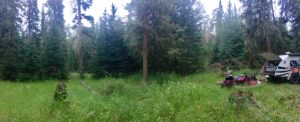 I couldn’t overthink camp set up because there was only one possible, perfect option. Shade for the camper, space for the shower/bathroom,
I couldn’t overthink camp set up because there was only one possible, perfect option. Shade for the camper, space for the shower/bathroom,  stumps and cut timber for tables and chairs. The meadow was just right for optimum solar collection and a small deer trail led to the creek. I quickly assembled a basic camp and slept deeply to the sound of running water.
stumps and cut timber for tables and chairs. The meadow was just right for optimum solar collection and a small deer trail led to the creek. I quickly assembled a basic camp and slept deeply to the sound of running water. Over coffee a curious bumblebee with an odd flight pattern feasted on purple flowers by my chair. He might have a limping flight but was not lacking in strength and agility I noticed lighting incense and settling into meditation.
Over coffee a curious bumblebee with an odd flight pattern feasted on purple flowers by my chair. He might have a limping flight but was not lacking in strength and agility I noticed lighting incense and settling into meditation. He was gone when I came back to physical awareness but returned often. His visits correlated with each new item I set up in camp. The two awnings, bathroom tent, a tablecloth over stumps to create a kitchen seemed to draw him like an inspector. He would hitch a ride on my feet, arms or hands.
He was gone when I came back to physical awareness but returned often. His visits correlated with each new item I set up in camp. The two awnings, bathroom tent, a tablecloth over stumps to create a kitchen seemed to draw him like an inspector. He would hitch a ride on my feet, arms or hands. I would too! I thought watching him crash land on the kitchen counter and crawl onto the raw veggies to nap.
I would too! I thought watching him crash land on the kitchen counter and crawl onto the raw veggies to nap. Bee arrived with a hard landing on the map and danced in circles along the winding map trail markings. Between dances he slept, so still the only sign of life was the light reflecting in his eyes. So bees sleep with eyes open?
Bee arrived with a hard landing on the map and danced in circles along the winding map trail markings. Between dances he slept, so still the only sign of life was the light reflecting in his eyes. So bees sleep with eyes open? By the third morning he had let go of gathering nectar in the meadow, preferring to stay snuggled in the altar bustling with a community of spiders, honeybees, beetles and ants. Extravert aye? I mused as I broke my “don’t kill the wildflowers” cardinal rule and placed his favorite purple flower next to him on the altar. He perked up and fed for hours between naps. I tucked him in that night with visions of angelic hives, prayers for peace, and a deep appreciation for his quiet companionship.
By the third morning he had let go of gathering nectar in the meadow, preferring to stay snuggled in the altar bustling with a community of spiders, honeybees, beetles and ants. Extravert aye? I mused as I broke my “don’t kill the wildflowers” cardinal rule and placed his favorite purple flower next to him on the altar. He perked up and fed for hours between naps. I tucked him in that night with visions of angelic hives, prayers for peace, and a deep appreciation for his quiet companionship. Seemed fitting. Like Elijah, Bee reminded me to be bit more mindful of daily manna in the wilderness that defy life or death polarities. This elusive, often fleeting awareness deeply restores a vibrant, healthy, happy harmony in every part of me and has since I was a girl living in the woods with creeks and ponds.
Seemed fitting. Like Elijah, Bee reminded me to be bit more mindful of daily manna in the wilderness that defy life or death polarities. This elusive, often fleeting awareness deeply restores a vibrant, healthy, happy harmony in every part of me and has since I was a girl living in the woods with creeks and ponds. “I’ve driven from coast to coast on backroads but never experienced this one yet,” I chuckled surveying the tire so flat it had collapsed in on itself with an angry pop and forceful hiss after I clipped the partially buried wedge of shale forcing a split in the sidewall of the tire.
“I’ve driven from coast to coast on backroads but never experienced this one yet,” I chuckled surveying the tire so flat it had collapsed in on itself with an angry pop and forceful hiss after I clipped the partially buried wedge of shale forcing a split in the sidewall of the tire. I held up my hand to stop him. “There’s just one more thing I should show you before you volunteer to help. It’s quite the hassle,” I warned moving to the rear of my car to open the hatch and reveal the solid wood chest of drawers built to fit in the full cargo area of the Subaru. My favorite carpenter had built it for me to haul my gear. With all the drawers removed it still takes two strong people to lift. Someday I’ll find someone to build it out of lightweight aluminum but for now this 300 pound behemoth serves me well.
I held up my hand to stop him. “There’s just one more thing I should show you before you volunteer to help. It’s quite the hassle,” I warned moving to the rear of my car to open the hatch and reveal the solid wood chest of drawers built to fit in the full cargo area of the Subaru. My favorite carpenter had built it for me to haul my gear. With all the drawers removed it still takes two strong people to lift. Someday I’ll find someone to build it out of lightweight aluminum but for now this 300 pound behemoth serves me well. “I’m going to need one of you to help back here,” he quietly motioned.
“I’m going to need one of you to help back here,” he quietly motioned. And family they are. Three strapping brothers, their sister, mother, and a sister- and brother-in-law out for a picnic near beautiful meadows and old mine in Castle Peak wilderness area of the Black Hills National Forest in South Dakota.
And family they are. Three strapping brothers, their sister, mother, and a sister- and brother-in-law out for a picnic near beautiful meadows and old mine in Castle Peak wilderness area of the Black Hills National Forest in South Dakota. With a grateful heart we shook hands, hugged thank you’s and good byes and went our separate ways. Just as I was getting in my car a mammoth, cobalt blue 4×4 pick up pulled up and offered help. I shook his hand in introduction and George swore I was the spitting image of his cousin. He may have missed out on the heavy lifting but he did stay in my site until we hit paved road where he waved good-bye.
With a grateful heart we shook hands, hugged thank you’s and good byes and went our separate ways. Just as I was getting in my car a mammoth, cobalt blue 4×4 pick up pulled up and offered help. I shook his hand in introduction and George swore I was the spitting image of his cousin. He may have missed out on the heavy lifting but he did stay in my site until we hit paved road where he waved good-bye. A week earlier when I entered the deep forests, meadows, creeks and cliffs of the Black Hills I immediately felt peace, safety and belonging in my marrow. My sleep has been deep and filled with adventurous dreams of close-knit family living here for generations. My camp in the pine and spruce forest has been busy with visitors of all kinds. The same bumblebee lived with us for three days. Two majestic bucks visit the
A week earlier when I entered the deep forests, meadows, creeks and cliffs of the Black Hills I immediately felt peace, safety and belonging in my marrow. My sleep has been deep and filled with adventurous dreams of close-knit family living here for generations. My camp in the pine and spruce forest has been busy with visitors of all kinds. The same bumblebee lived with us for three days. Two majestic bucks visit the  leaping brookies. Hummingbirds dive for my morning maple syrup. Angels dance with fairies and family long gone embrace me with a smell, a warm breeze, and memories of laughter and love. In all my travels it’s the longest I’ve stayed in one spot and I have no desire to leave.
leaping brookies. Hummingbirds dive for my morning maple syrup. Angels dance with fairies and family long gone embrace me with a smell, a warm breeze, and memories of laughter and love. In all my travels it’s the longest I’ve stayed in one spot and I have no desire to leave. In that instant I felt her unity with my journey in the very empty seat beside her. Yes the blessing of close, loving, grown children surrounded her. But she too knew unbearable loss and lonely, dark grief. I’ll never forget the glow of her face when she observed “you are free!” I think like me, she lives a celebrated recovery beyond the losses with a grateful mindfulness of the gift of each breath every day simply because we are alive.
In that instant I felt her unity with my journey in the very empty seat beside her. Yes the blessing of close, loving, grown children surrounded her. But she too knew unbearable loss and lonely, dark grief. I’ll never forget the glow of her face when she observed “you are free!” I think like me, she lives a celebrated recovery beyond the losses with a grateful mindfulness of the gift of each breath every day simply because we are alive. Dear West Family and blue pick up George know that I still feel your infusion of safety, reassurance, and rescue. Your big medicine is now a part of me available to ground and guide me during the next calamity. May your blessings return to each of you in the gentle breeze with my grateful hug.
Dear West Family and blue pick up George know that I still feel your infusion of safety, reassurance, and rescue. Your big medicine is now a part of me available to ground and guide me during the next calamity. May your blessings return to each of you in the gentle breeze with my grateful hug.
 But on Sunday Oak Creek Canyon reminds me of ants at a summer picnic. Sedona tourism has tripled in the last decade with over two million annual visitors. On any given weekend thousands pack the roadway, parking lots overflow both sides of the highway, and bumper-to-bumper one-lane traffic inches through the gridlock. The highway flows into downtown Sedona and every artery is an organized bottleneck thanks to abundant roundabouts.
But on Sunday Oak Creek Canyon reminds me of ants at a summer picnic. Sedona tourism has tripled in the last decade with over two million annual visitors. On any given weekend thousands pack the roadway, parking lots overflow both sides of the highway, and bumper-to-bumper one-lane traffic inches through the gridlock. The highway flows into downtown Sedona and every artery is an organized bottleneck thanks to abundant roundabouts.
 Take HW 89A west from Sedona to mile marker 365. Turn right on Forest Rd 525 – Red Canyon Road. From entry to Palatki Ruins are many clearly marked pullouts. Some can accommodate numerous rigs while others are perfect for a small tent.
Take HW 89A west from Sedona to mile marker 365. Turn right on Forest Rd 525 – Red Canyon Road. From entry to Palatki Ruins are many clearly marked pullouts. Some can accommodate numerous rigs while others are perfect for a small tent. Mongollon Rim with Secret, Bear, and Lost Mountains on the east and Black, Sugarloaf, and Casner Mountains on the north and west.
Mongollon Rim with Secret, Bear, and Lost Mountains on the east and Black, Sugarloaf, and Casner Mountains on the north and west. Like all of Sedona it can get crowded and it’s worth venturing past the first spots. The area has many
Like all of Sedona it can get crowded and it’s worth venturing past the first spots. The area has many 
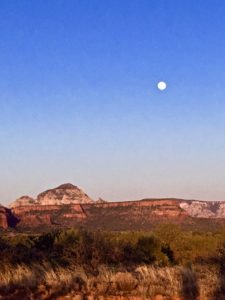 that seem close enough to touch.
that seem close enough to touch.

 National Forest campsites are larger than the
National Forest campsites are larger than the 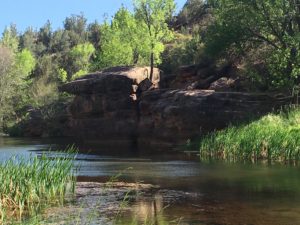
 It can accommodate small RV’s and tent campers on acres of open pasture and forested shade. Rates range from $20-$35/day. Camp Avalon is located at 91 Loy Lane in West Sedona off of 89A. Reservations available at
It can accommodate small RV’s and tent campers on acres of open pasture and forested shade. Rates range from $20-$35/day. Camp Avalon is located at 91 Loy Lane in West Sedona off of 89A. Reservations available at  The hiking trails of Sedona are some of the nations best so it’s worth the realities of camping in a heavy tourist area. The
The hiking trails of Sedona are some of the nations best so it’s worth the realities of camping in a heavy tourist area. The 
